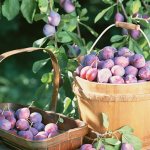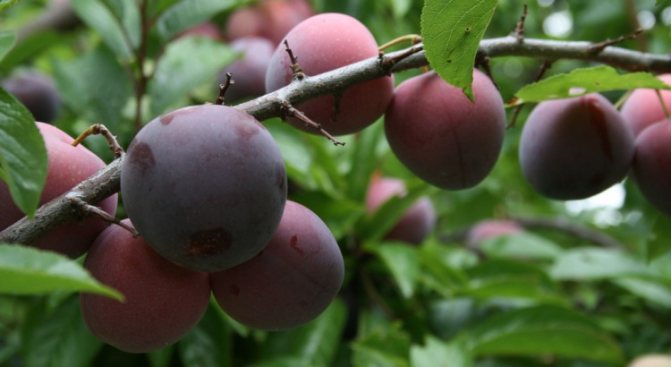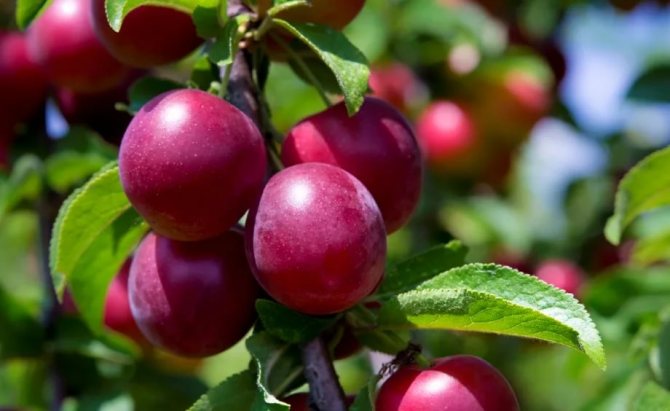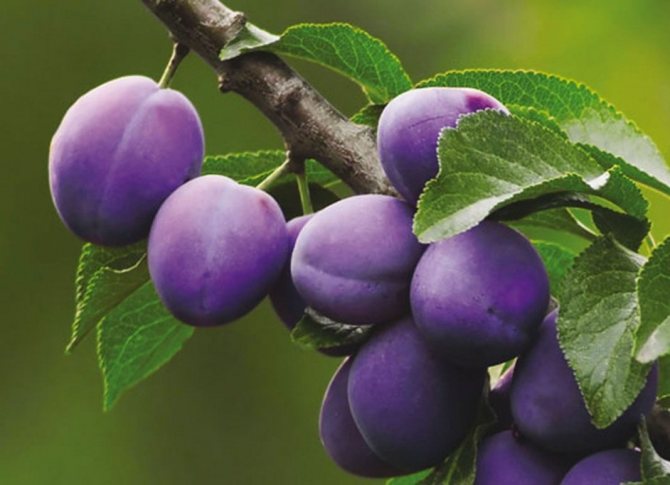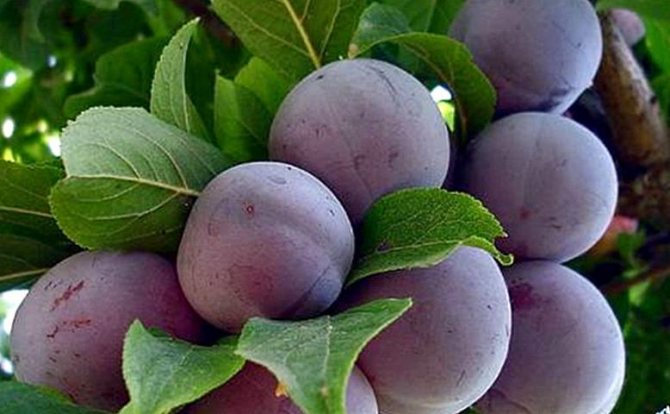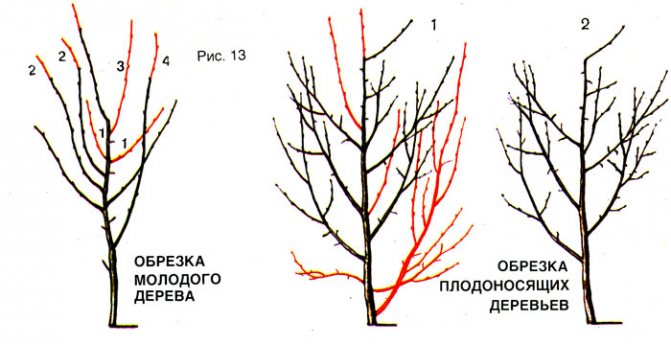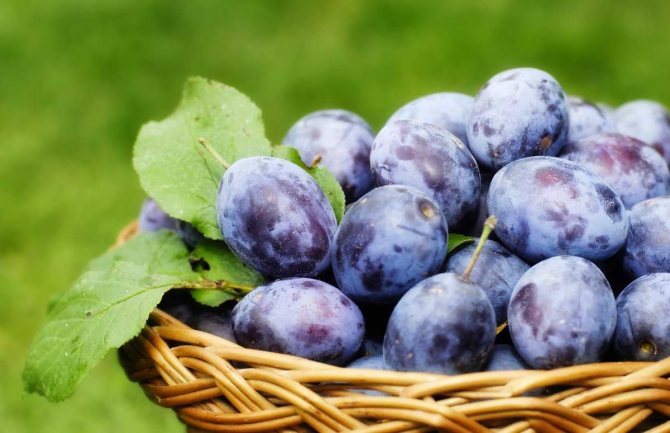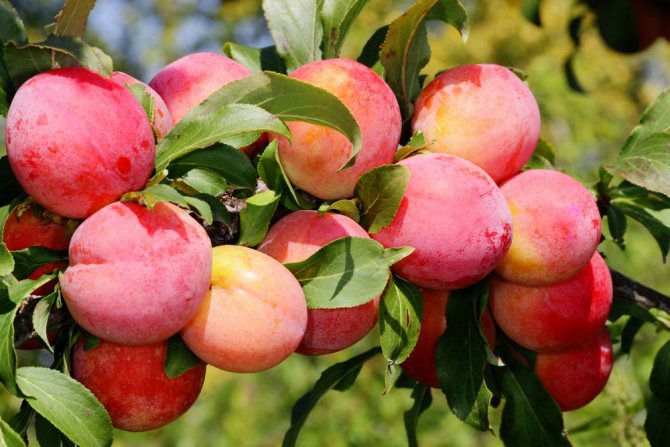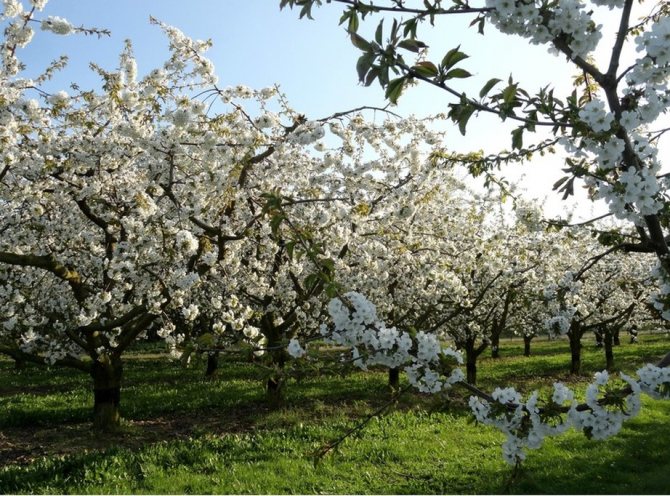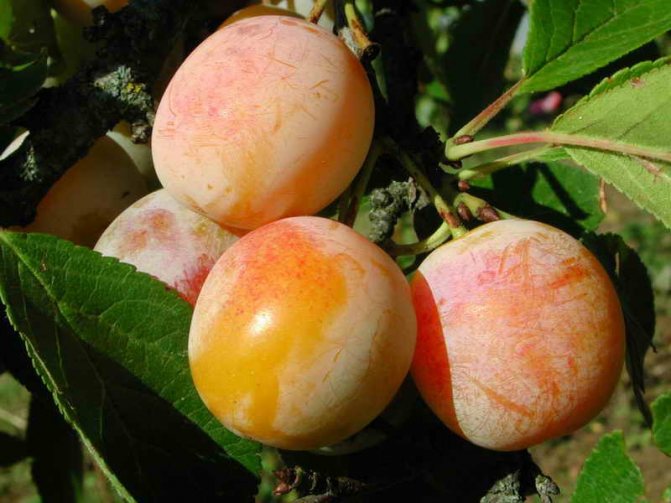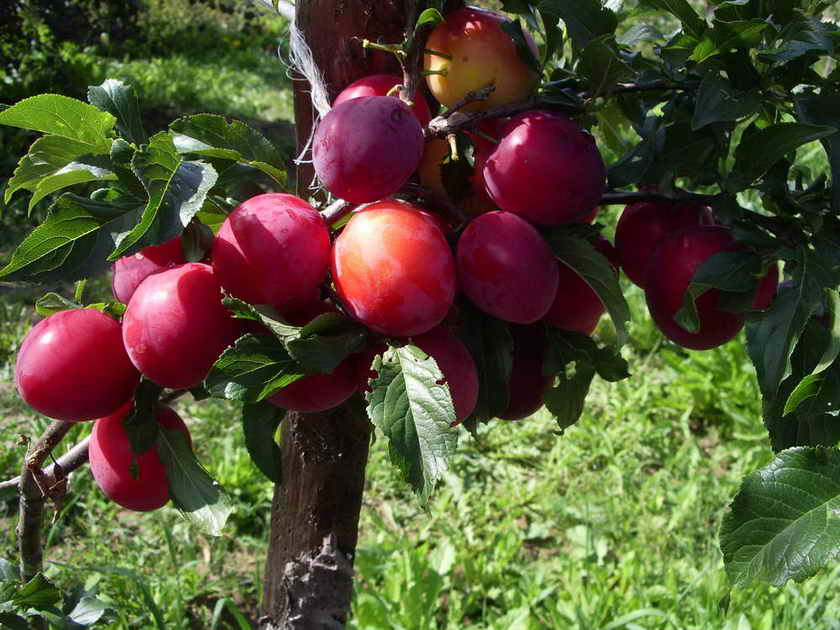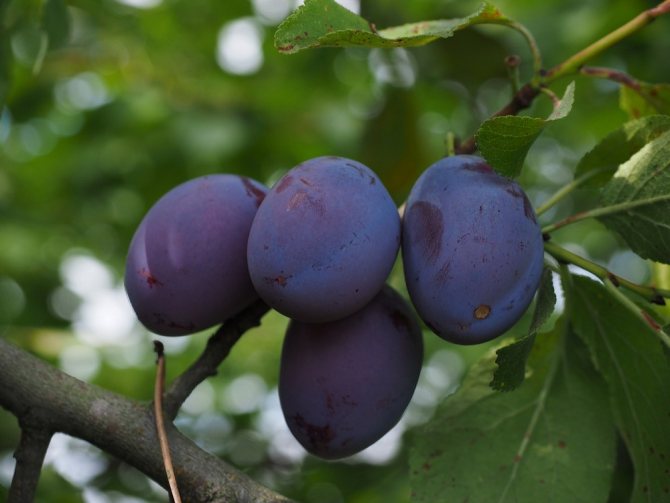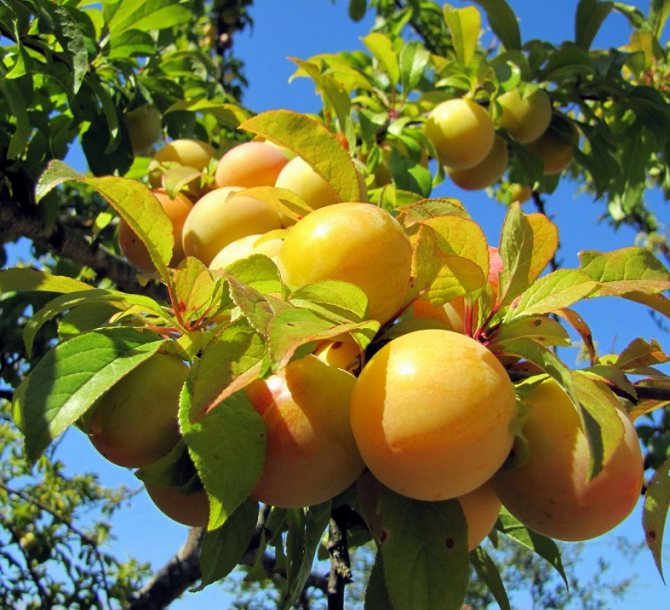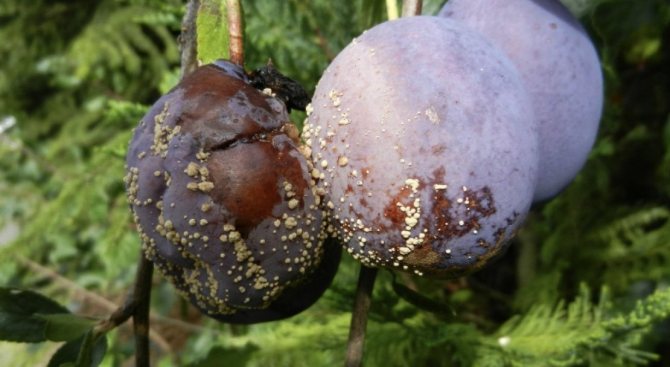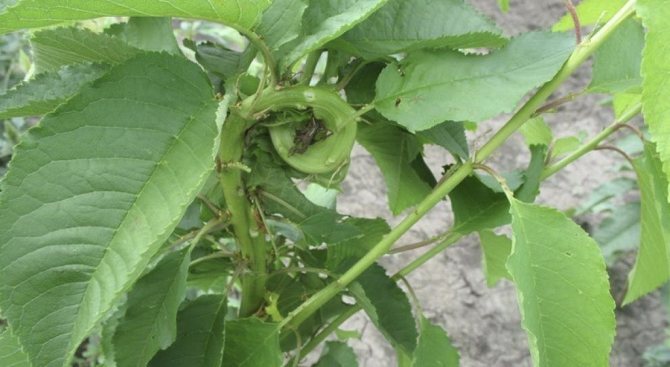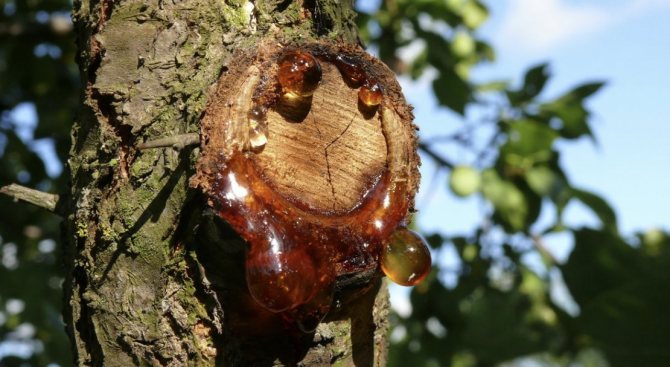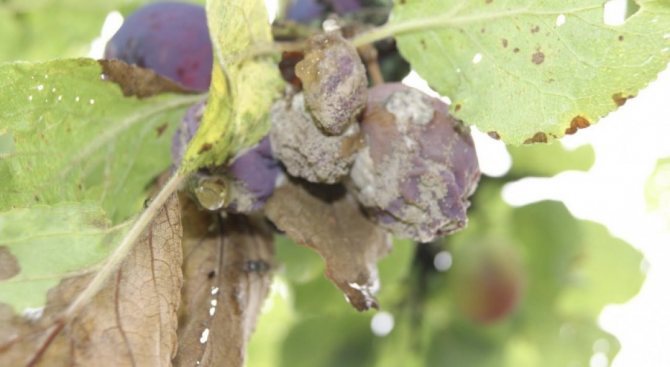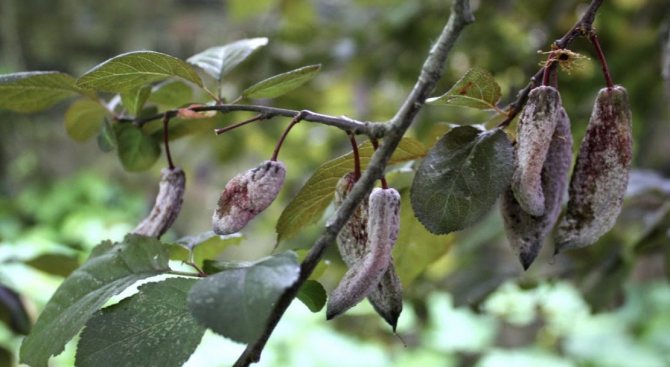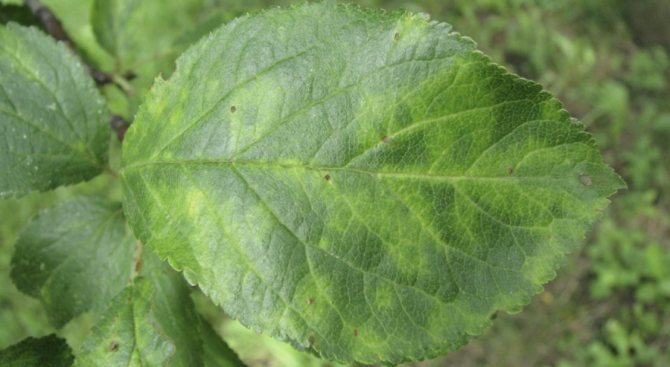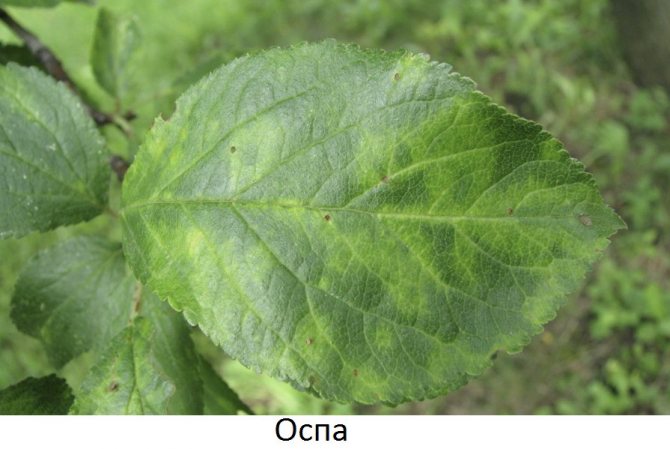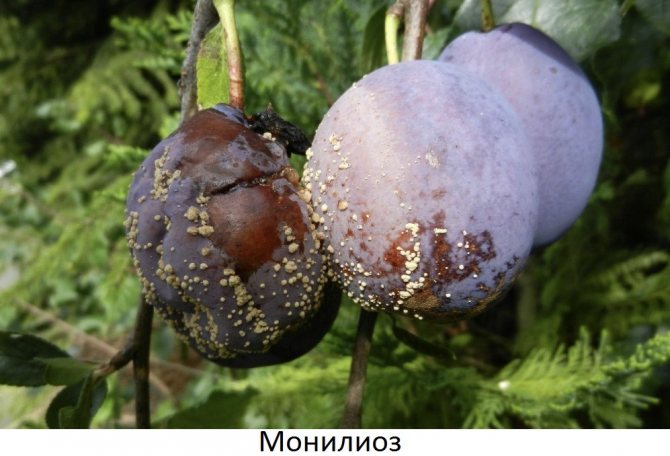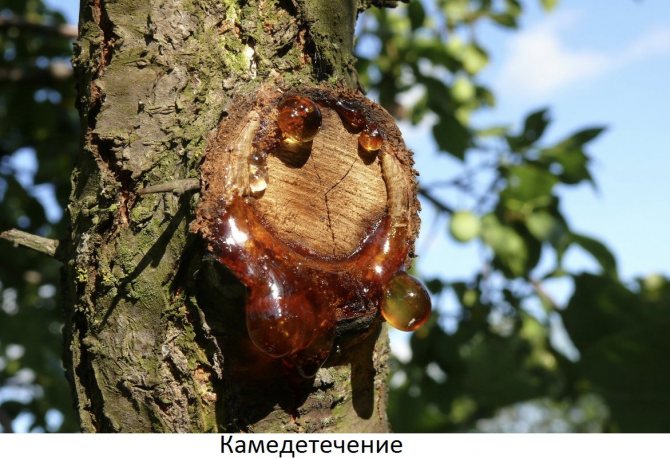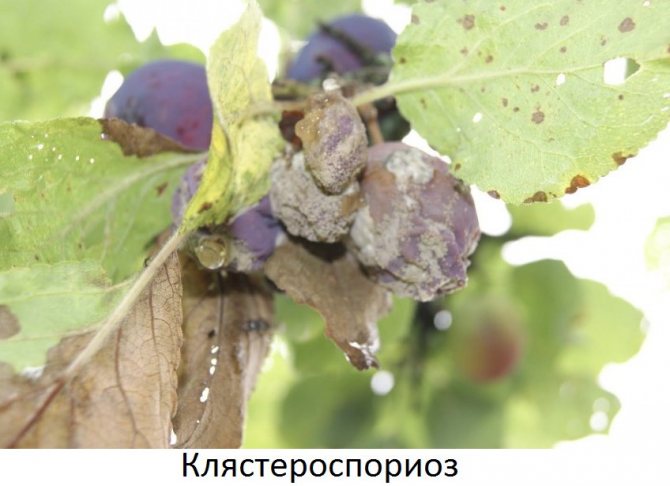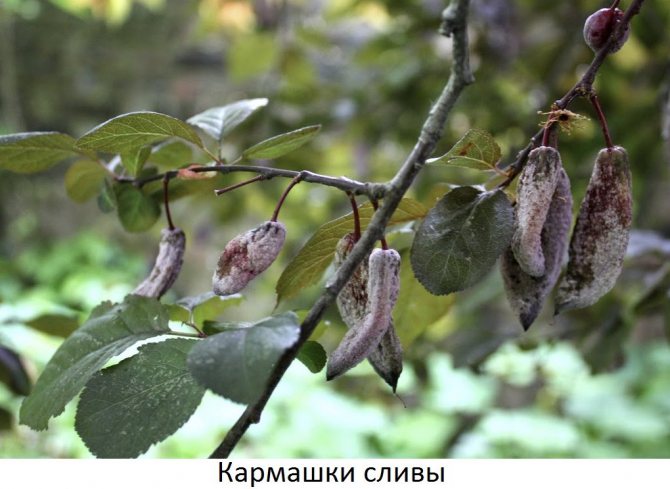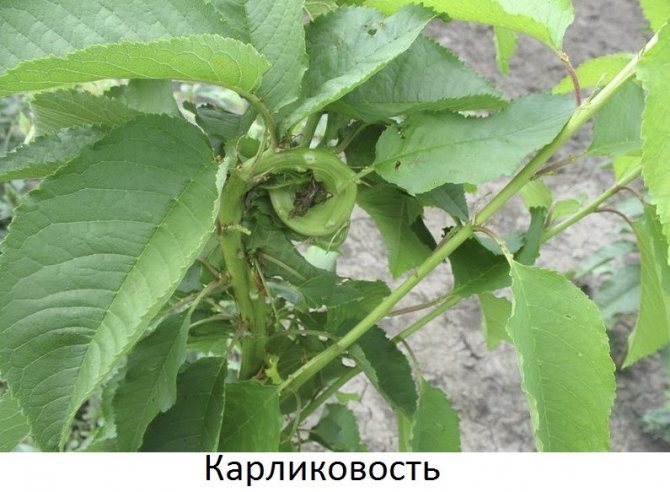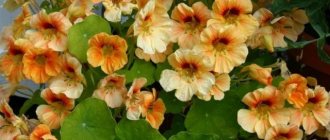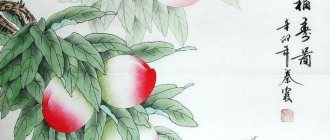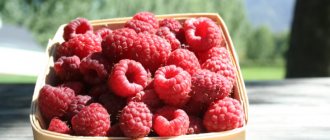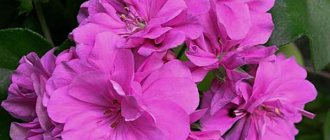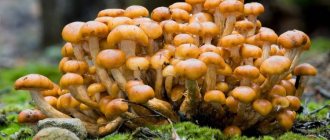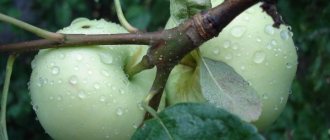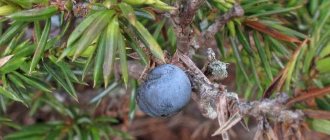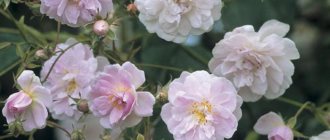Features of growth and fruiting
Plum grows as a tall shrub or tree. The crown is spreading or narrow pyramidal, branches drooping or straight. The ground part varies from 2 to 8 meters. It all depends on the variety, soil, climatic conditions. Under favorable conditions, the height of some species reaches 10 meters or more.
In the first 4-6 years, there is an intensive growth of branches. Fruiting slows down the process.
In the Krasnodar Territory, vigorous varieties are grown: Vengerka, Green Renklod, Ontario.
In central Russia, medium-sized (Washington, Hungarian Azhanskaya) and low-growing (mirabeli) varieties are widespread. The area of the crown of the latter is up to 40 sq. m.
Plum begins fruiting at 3-4 or 5-6 years. Continues to produce crops for 20 years.
On the plum, simple (growth) and mixed (leaves, flowers) buds are formed. Formed singly and in groups. Further, from the group buds, bouquet twigs and spurs are formed. The latter form growth buds.
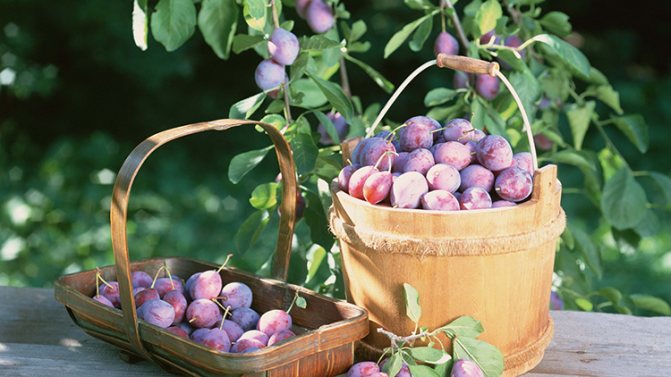
By the nature of fruiting, plum varieties are divided into groups:
- Varieties bearing fruit on last year's increments. The branch is dominated by group buds. The shape of the crown is spreading. These include American, Chinese, Ussuriyskaya, plums. Shoot growth is supported to accelerate the emergence of fruits.
- Fruiting on a two-year-old branch. Fruits are formed on spurs and bouquet branches. The life expectancy of spurs is 5 years. Varieties of this type have a pyramidal crown shape (Anna Shpet, Vengerka Domashnaya, Peach).
- Mixed fruiting. Both options are present in the group. Most varieties with 3 fruiting groups: Tula black, Vengerka Moscow, Mirnaya, Skorospelka red, Memory Timiryazeva, Volzhskaya beauty, Ochakovskaya yellow. Varieties differ in high yield, early ripening.
The peculiarities of fruiting are taken into account when pruning, which regulates the yield.
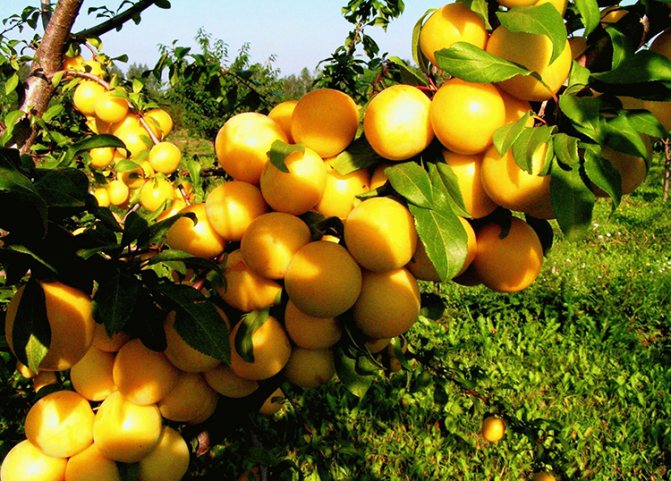

Characteristics and description of the tree
Plum is a plant of the Rosaceae family. Grows in bush form or formed by a tree. Plum height can vary from 2 to 16 m. The root system of the plant is rather large. It grows more to the sides. The depth of the rhizome is about 40-60 cm. Roots can branch out to the sides with a length of 3-6 m. The ground part of the plant consists of a stem and a crown.
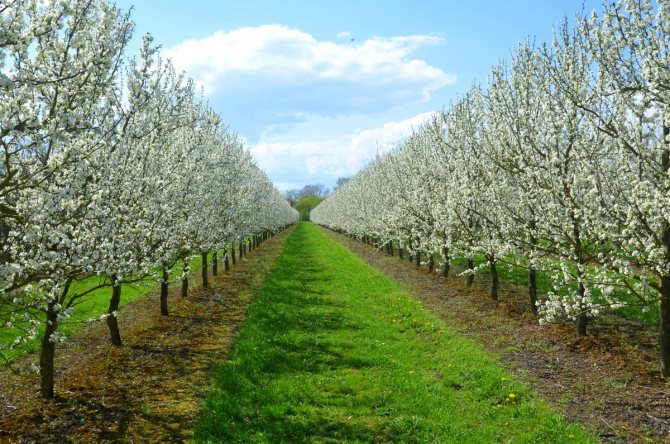

In turn, the crown is formed from skeletal, semi-skeletal branches, one-year-old growths and growing shoots. The pillars are aligned. The wood is gray-brown colored, smooth.
In some specimens, the branches are densely covered with thorns. The buds are usually simple, that is, only flower or only growth buds. Less common are specimens with mixed buds containing growth and flower rudiments at once.
Did you know? Slivovitsa - moonshine with plums.
Elongated sheet plates. The surface of the leaf is leathery, the upper part is one tone darker than the inner one. Depending on the species, the leaves can be colored in different shades of green and purple.
Inflorescences of 2-3 flowers are formed on one-year-old growths and bouquet shoots. The flower is white, 2 cm in diameter. Stamens and anthers are located inside it. Flowers open earlier than leaves or almost simultaneously with them.Blooming plum is highly decorative.
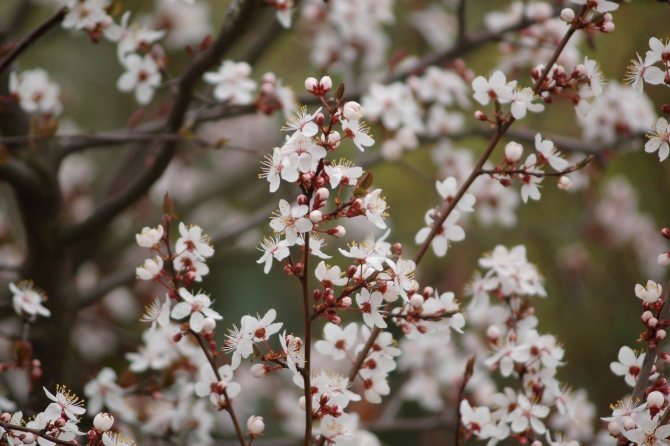

The level of self-fertility of a plant depends on the variety. In any case, if there are pollinators with a similar flowering period at a distance of 4 to 20 m from the plum, the yield will be significantly higher. After flowering, drupes appear in place of the inflorescences, which are fruits.
Fruit color ranges from light yellow to almost black. On all fruits, without exception, there is a waxy coating of a transparent white color. The pulp of the fruit is sweet and sour, tasty, juicy. The structure can be dense, melting and always fibrous. The latter feature of the pulp can be expressed more actively or less, depending on the variety.
Find out also
How is cherry plum different from plum?
The plum has a lifespan of about 30 years. Of these, active fruiting falls on from 15 to 25 years. Most of the new hybrids are characterized by high resistance to frost, drought and disease.
It should be remembered that the roots of the plum are located superficially, therefore, a prolonged absence of watering will lead to the drying out of the plant. Plums are not demanding on the quality of the soil, however, they develop poorly on heavy clay soils. The most suitable are loamy and sandy loam soils with a thick fertile layer.
In use, the culture in question is very versatile and is applied:
- as a decorative element in landscape design, allowing you to correctly place accents;
- as a late spring honey plant;
- a fruit and berry plant grown in order to obtain products on an industrial scale for processing, commerce, consumption in natural form;
- for the production of essential oil, in composition close to almond.
Common varieties of plums
According to the degree of ripening, plums are divided into the following groups: very early, early, medium, late.
Very early
Red ball... The variety was bred by breeders by crossing the Ussuriysky red and American Burbank. The tree stretches up to 2.5 m in height. The shape of the branches is spreading. Early flowering, leaves appear later than buds.
The fruits are large (40 g), red in color. The taste is sweet and sour with a pronounced aroma. Fruiting peculiarity - group 2 (on spurs). The crop is harvested 2-3 years after planting.
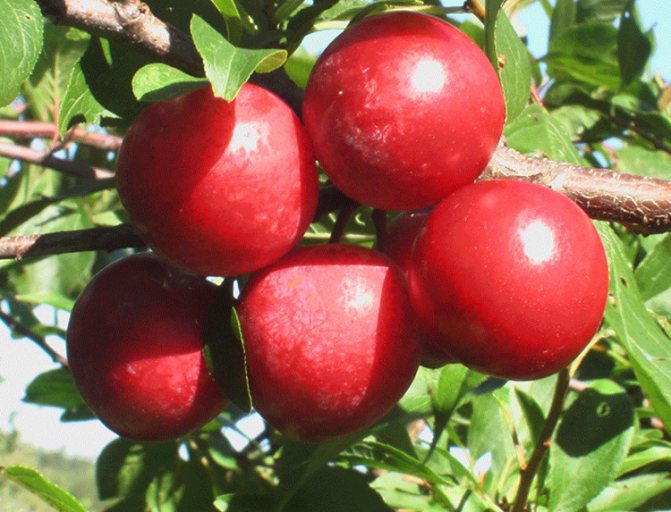

Sapa... The dwarf plant stretches up to 1.5 m in height. The variety is obtained by crossing cherry and plum. It is a bush. Fruits grow on annual increments. In the axils of the leaves, up to 6 flower buds are formed. Therefore, the variety pleases with a bountiful harvest.
Fruiting occurs in the second year after budding. At 3 years of fruiting, Sapa yields up to 4 kg. The gains are regulated by systematic pruning. Fruits are small - 9-10 g. The flesh of a dark burgundy color is used for coloring marmalade, wine. The taste is reminiscent of a turnip.
Breeders use Sapa for crossing peaches, apricots.
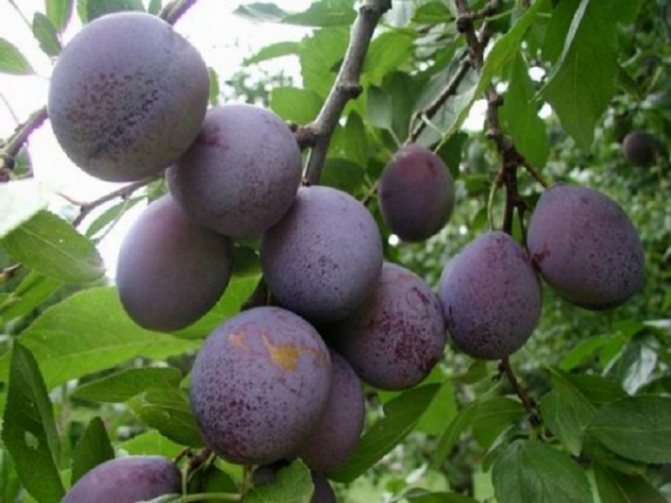

Opata... Bonsai up to 2 m in height. Product from crossing plum and cherry. The fruits are used for technical purposes.
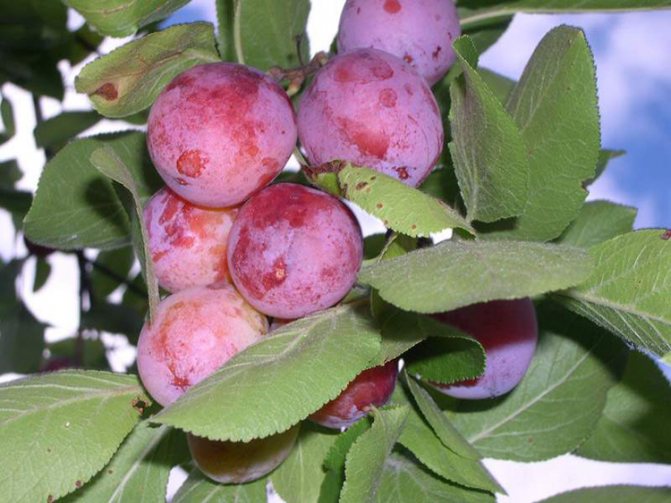

Early
Manchu beauty... The variety is a derivative of 3 varieties: Chinese, Ussuriysk, "Simona". Growth reaches 1.8 m. The plant belongs to self-infertile plants. A pollinator is planted next to it. The Ussuriyskaya plum copes well with this role.
Regular fruiting begins 3 years after planting. Ripening period August - September. The mass of yellow-orange fruits is 15 g. Fruiting of fruits is formed on bouquet branches.
After ripening, all fruits must be harvested. Otherwise, the plum will throw them off the tree.
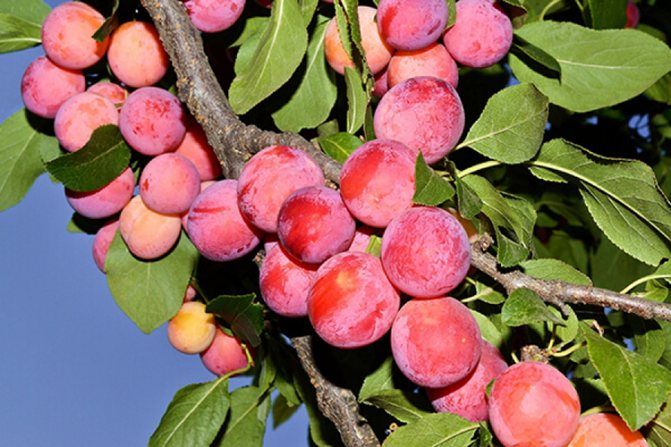

Spark... Medium-sized tree with high yield. Fruits are ovoid, weighing 18 g.The color is dark red with a touch.
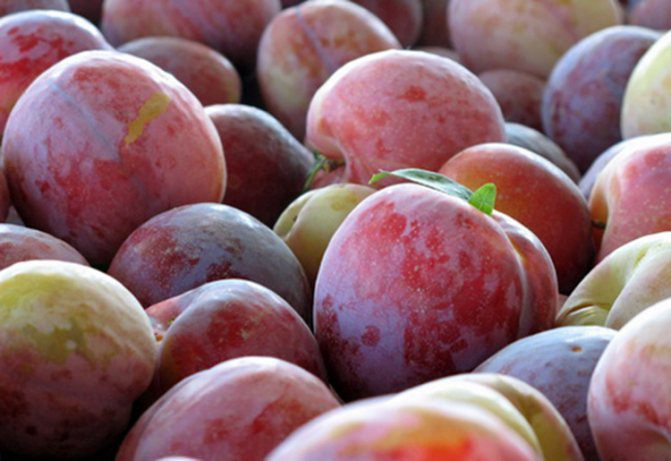

Egg yellow... Trees bear fruit for 6-7 years. The yield is high. The fruits are large. The form is ovoid, orange-yellow.
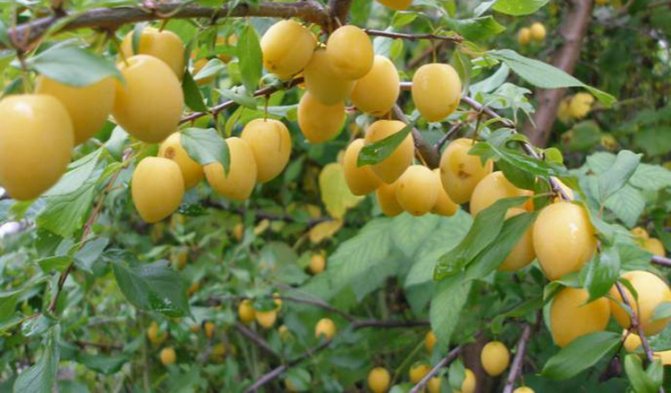

Medium-fruited
Peach... Plum prefers southern regions due to poor winter hardiness. Fruiting on bouquet branches appears at 5-7 years. The yield of the tree increases over time. At 25 years old, peach plum bears fruit up to 50 kg per unit. The weight of one berry varies from 45 to 50 g.
The color of the plum changes depending on the weather. In cold weather - a greenish-yellow color, in sunny, warm weather - a pink blush covers almost the entire fruit.
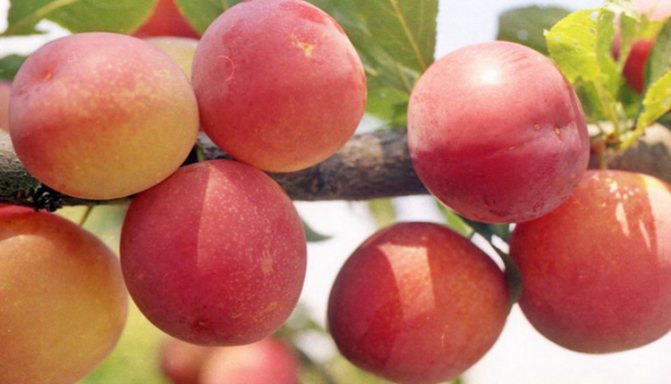

Victoria... Plum belongs to self-fertile varieties with English origin. Can be a pollinator of varieties Anna Shpet, Vengerka, Kirke. The trees are large with a spreading crown. Fruiting for 3-4 years.
Fruits are reddish-yellow, light purple on the sunny side. There is a wax coating. Fruit weight 40-45 g. Likes moist fertile soils with the presence of lime.
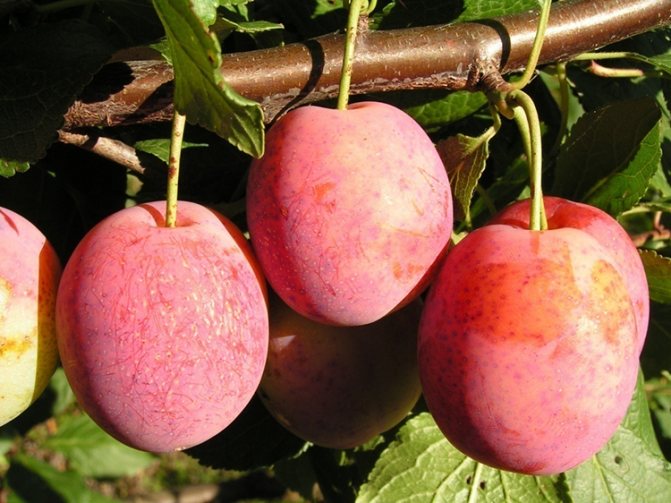

Italian... The homeland of the variety is Italy. The tree is frost-resistant. Preferred southern regions. Under favorable conditions, at the age of 5-6 years, the yield of the Italian woman is 50 kg. At 10 years old - 100.
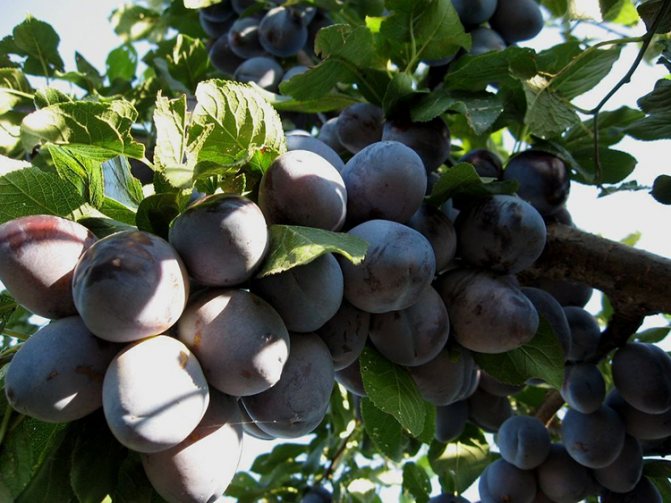

Hungarian... Tall tree with a spreading crown, pyramidal shape. A frost-resistant variety, disease-resistant. On moist fertile soils, the yield is 150-180 kg.
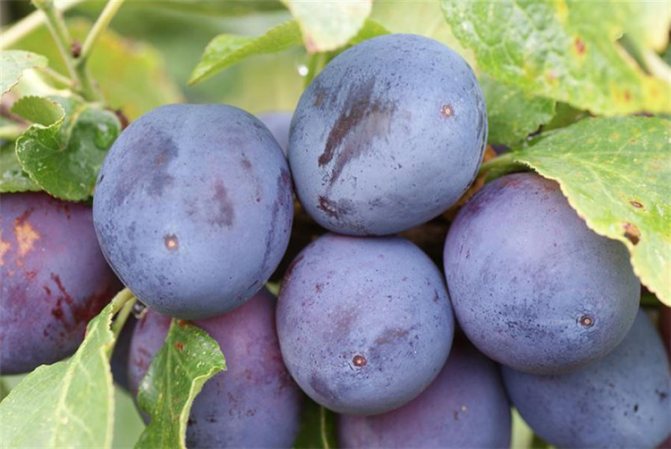

Greengage... The tall plant reaches 5-7 m in length. The crown is round. Fruits are black and blueberry with a waxy coating.
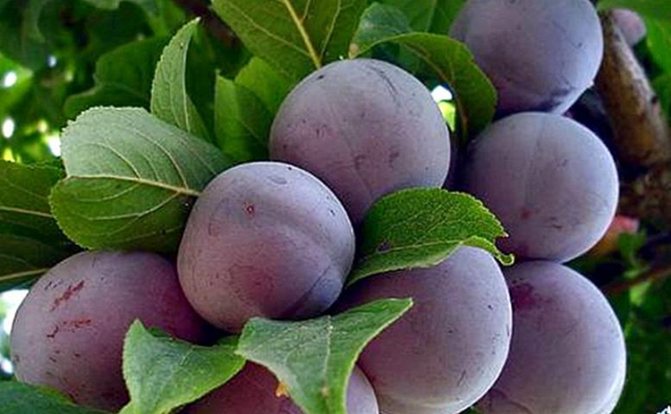

Late-fruited
Washington... The tree is partially self-fertile, medium in size. Pollinator can be Anna Shpet, Peach plum. The crown is spherical. Leaves appear after flowering. Good fruiting occurs at 7-8 years. Fruits are light yellow, large.
In regions with humid climates or rainy summers, Washington is affected by fruit rot. Damp weather affects palatability.
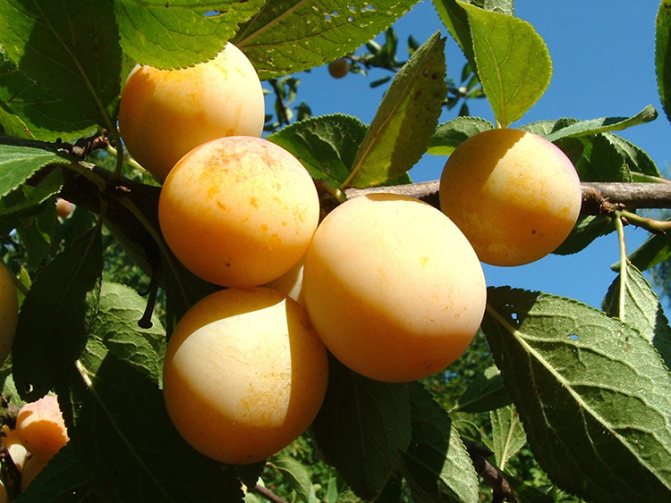

Renclaude Ullensa... The tree is vigorous. Begins fruiting from 5-6 years. The yield is high. Prefers the climate of the southern regions. Fruits are green, when fully ripe they acquire a yellow tint. The pulp is juicy, sweet.
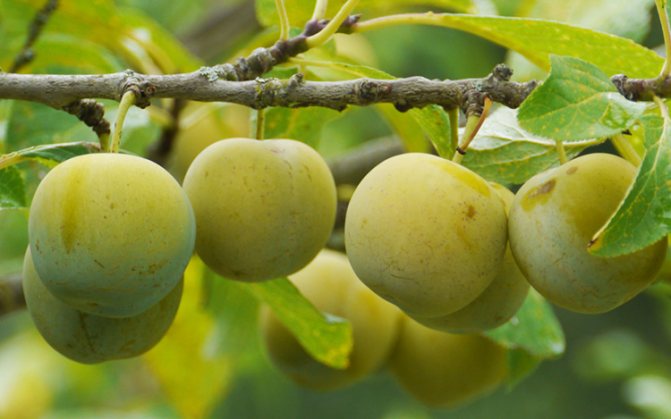

Why are plum fruits useful?
Plum fruits contain: sugars — up to 14.5%; organic acids — up to 2.2%; pectin — up to 0.7%; tannins — up to 0.4%; vitamin C — up to 20 mg%; vitamins B1, B2, B3, B9, K, PP; carotene, mineral compounds.
Biologically active substances found in plum fruits are able to prevent the formation of blood clots in blood vessels and strengthen capillaries. Dried plum fruits are useful for the prevention of atherosclerosis and diseases of the gallbladder, they are recommended for diseases of the liver and kidneys, weak bowel function.
It should be noted that dried plums contain more sugars than fresh ones, so they should not be consumed for diabetes and obesity.
Fresh fruits are used and for processing (prunes, compotes, juices, preserves, liqueurs, jam, marmalade).
Incredibly, the plum as such was not cultivated from a wild plant. Three millennia ago in the Caucasus, cherry plum hybridized in a natural way with thorns, and a new culture immediately began to be erected by people. Her Majesty Plum came to Europe and Asia only after many centuries, although it took root there almost instantly. Today, plums are grown in Africa, America and even Australia.
Naturally, for us, the plum is a familiar fruit available to every gardener. And why did the inhabitants of other countries like it so much?
Plum is a tree of the plum or almond subfamily. It grows up to 5 meters high. Plum has simple leaves, lanceolate, framed by teeth, and pink or white flowers with five petals, collected in umbrellas of five to six inflorescences, or single.
Choosing planting material
When choosing planting material, varieties are taken into account that are adapted to the conditions of a particular region.


Trees are classified into self-fertile and self-fertile varieties. If the second option is chosen, then you need to take care of the acquisition of pollinating varieties.
When buying a seedling, pay attention to the appearance:
- the root system must be healthy, without dry parts;
- the presence of a tag containing information about the manufacturer, characteristics of the variety is mandatory;
- seedlings with an open system should not show signs of disease, spots, damage, light-colored roots;
- annual seedlings in height should be 1-1.3 m, grown from stone - 1.5 m. Deviation from the norms indicates improper care and violation of technology in growing.
Experienced gardeners are advised to choose two-year-old seedlings. They take root quickly and tolerate stress more easily than older specimens.
For spring planting, seedlings are bought in the fall and buried in the ground at an angle of 60 degrees. to a depth of 40 cm.
Alyonushka
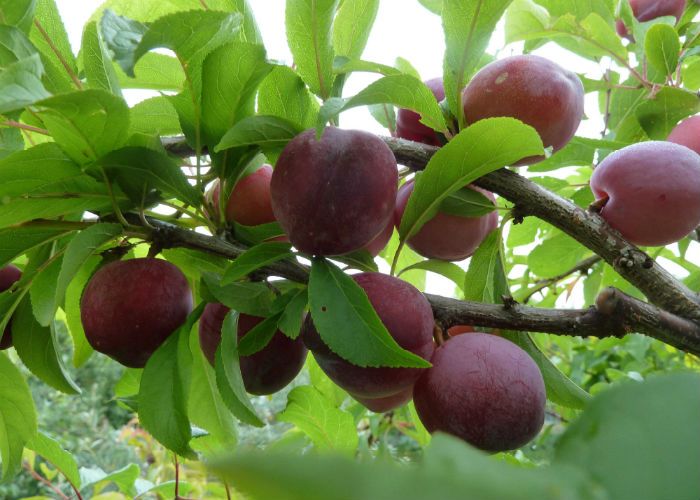

Plum variety with early ripeness. The height of the tree usually does not exceed 3 meters. The fruits are rounded, they reach 40 mm in diameter, weigh 30-40 grams, the skin tone is deep red. The pulp is medium-dense, juicy, orange color, sweet and sour taste. When ripening, the fruits do not crack, the variety is frost-resistant and practically immune to most ailments that plums get sick with.
Choosing a soil for planting
The composition of the earth is chosen according to the variety. For oval-shaped fruits, clay soils are suitable, round - loamy chernozem. Plums can grow on dry sandy loam soils if the soil is well fertilized beforehand. To do this, humus is added to the soil in the spring.
Plum refers to acidic soils capriciously. Increased acidity is determined visually. Plants will be an indicator: sorrel, heather, mint, plantain. You can lower the level by liming, adding ash, dolomite flour.
Groundwater should be located at a distance of 1.5 m, not higher.
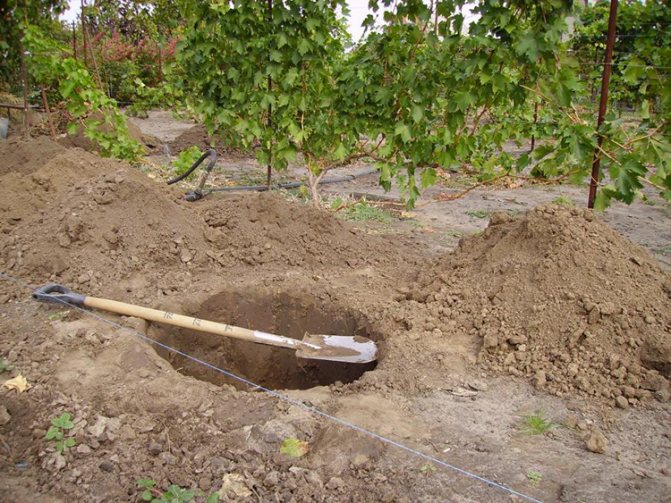

Is plum a berry or a fruit?
The life form of the plum tree. However, over time, many hybrid varieties have been developed that are shrubs. It was this fact that led to the difficulty in classification and provoked many disputes as to whether the fruit should be considered fruit or whether it should be considered berry crops, since the harvest harvested from shrubs is called berries.
Did you know? Extract from fruits and seeds of plums is used to create skin care products aimed at maintaining tone by stimulating collagen production.
In terms of botanical definition, plum is a fruit. The plum plant belongs to the drupes. After flowering, single-seeded fruits are formed on it, the seed of which is contained within a hard stone. In berries, the fruits, in most cases, are multi-seeded, and are not an extension of the stem, but grow on a long stalk, which dries out over time, after which the fruit falls off.
Autumn and spring planting of plums
Plums are planted in autumn and spring. In the southern regions, it is preferable to plant in the fall, in the middle lane - in the spring.
The signal for planting in spring is completely thawed soil. The work must be done within two weeks. Start preparing the seat in the fall. The width of the pit is 70-80 cm, the depth is 40-50.
For poor loam, the size is chosen larger (width 2 m, depth - 1). The bottom is covered with a layer of clay (5-10 cm) and the earth is tamped. Above is a fertile layer with fertilizers.
Autumn planting should be carried out 1.5-2 months before stable frosts. During this period, the plum manages to take root. The landing site is prepared 15 days before landing. In the autumn, fertile soil with humus (1 bucket), superphosphate (350 g), potassium salt (65 g) are added to the pit. The dense soil is mixed with sand.
Fertilizers with nitrogen are not used in autumn. Nitrogen stimulates growth.
Zarechnaya early
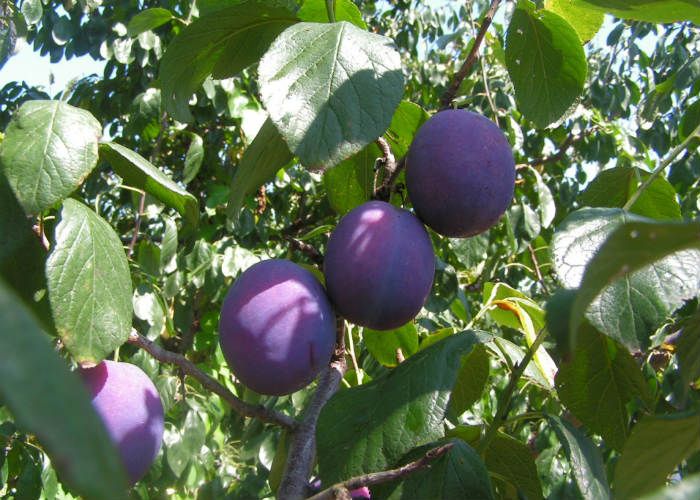

Early ripening high-yielding variety. The plant is medium-sized, the crown is compact. When formed, the fruits look like a slightly rounded oval, the maximum weight of one is 50 grams, the integumentary color is deep purple with a thick bloom. The structure of the pulp is dense, the color is amber, the taste is sour-sweet. The variety stands out among the comrades-in-arms for its frost resistance, the annual yield is stable, the commercial qualities of the fruits are high.
Seedling care
After planting, seedlings need to care for the near-stem circle, watering, mulching, feeding, pruning.
We take care of the near-trunk circle
The radius of 1 meter from the seedling is called the trunk circle. After planting plums, they pay special attention to:
- timely release from weeds;
- loosen the soil regularly;
- root shoots are removed up to 4-5 times during the growing season;
- the garden is over 2 years old, herbicides are introduced into the trunk circle. Work is carried out in calm weather. At the same time, do not allow the herbicide to get on the foliage, stem. Solution consumption 20 g per 1 sq. m.
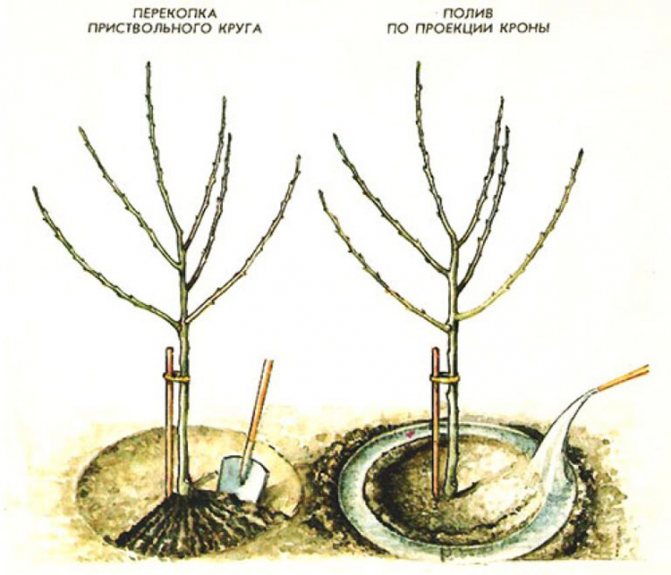

Watering and mulching
The plant receives the first watering during planting (2 buckets). Water saturates with moisture and compacts the soil.
Next, watered once a week during the summer. Irrigation is best done with a rainwater installation (2 hours), so as not to erode the fertile layer of the near-trunk circle. Or from a watering can, 20-30 liters of water under one tree.
In dry summers, watering is done more often, in rainy ones - less often.
In the second year of the seedling's life, irrigation is reduced. Watering is done as needed: heat, no rain.
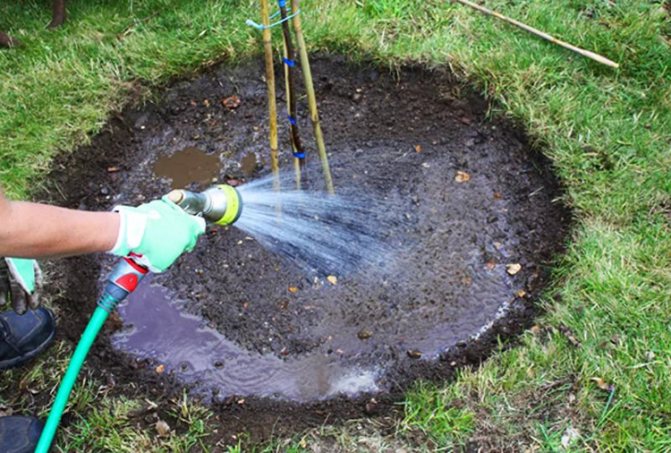

Herbicides are not required if the tree trunk is mulched after watering. Sawdust, straw, coniferous branches, peat are used as mulch. Mulching will retain moisture and protect against weeds.
It is very important to saturate the soil with moisture in the fall. Before the trees have shed their leaves. Water every day for 7 days.
Plum gets a lot of benefits from sprinkling. Young seedlings are sprayed in hot weather and in autumn. In summer, procedures are carried out in the evening. Sprinkling young trees without leaves in autumn will help combat sudden temperature changes. Sprinkling starts in the evening and continues until dawn.
Plum dressing
Fertilizers that the seedlings received during planting are enough for 2 years. In subsequent years, the tree will need mineral and organic fertilizers.
In the third year, the plum is fed with urea (20 g) with the addition of urea (2 tablespoons), 5 liters. water. In the first decade of May, foliar top dressing is carried out with a working solution.
At the beginning of June nitrophosphate is introduced. Dose: 30 g of the drug per 10 liters. water. Foliar top dressing.
In mid-August, use superphosphate (2 tablespoons), potassium sulfate (2 tablespoons) in a bucket of water.
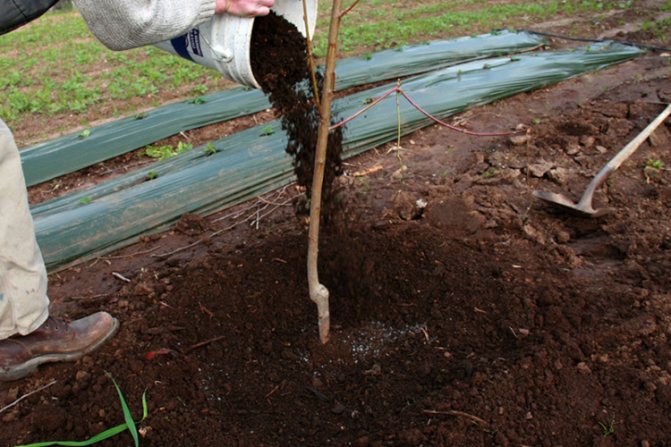

Root feeding is carried out in August:
- 15 g of potassium sulfate;
- 15 g superphosphate;
- 70 g of ash;
- 10 liters of water.
Retreat 80 cm from the trunk and make holes where the solution will be poured. Top dressing is combined with watering (25 liters of water for each plant).
The following are used as organics:
- dry chicken droppings. Dose: 1 kg for 3-4 liters of water. The mixture is left to ferment for 2 days. Before watering, dilute in a ratio of 1/10 l. water and mix thoroughly;
- humus.
Organic fertilizers are applied once every 3-4 years.
How to care for plums: protecting against disease
Plum rust.
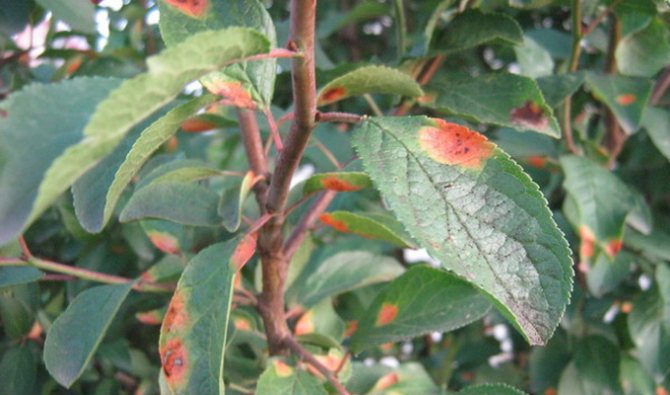

Rust (rust fungus) infects plum leaves, they are covered with numerous brown powdery pads of the parasite spores on the underside and sometimes on the upper side.
The mushroom overwinters on fallen infected plum leaves. In the spring, the spores germinate and infect the buttercup anemone (the second host of the fungus). Spring sporulation develops on its leaves, which causes primary infection of plum leaves. During the summer, rust causes new recontamination of plum leaves by summer spores.
Protective measures... It is necessary to carefully collect and destroy the affected fallen leaves on which spores winter, as well as anemone in and around the garden. With the massive development of the disease, plums are sprayed with a 1% Bordeaux mixture or copper preparations replacing it (2-3 times per summer).
Plum scab.
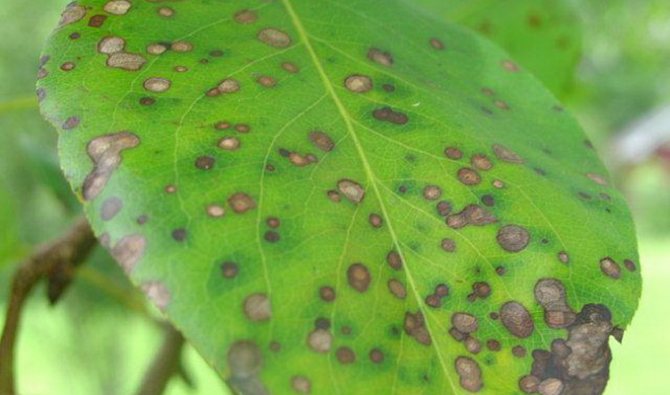

Plum scab affects fruits, leaves and shoots. Greenish-yellow spots appear on fruits and on the upper side of diseased leaves. The disease is spreading rapidly. Diseased leaves fall off prematurely, which makes the trees weaken, and their preparation for winter worsens. Fruits affected by scab crack, become ugly, woody. The mushroom hibernates on fallen leaves and shoots.
Protection measures. When caring for plums, it is recommended to collect and burn fallen leaves and fruits, digging the soil in the garden in autumn, spraying with a 1% Bordeaux mixture: the first before flowering, the second after flowering and, if required, the third after two weeks. Spraying is combined with treatments against the moth. Instead of Bordeaux mixture, you can use Agat-25K, Skor, Abiga-Peak preparations.
Pruning plums
Plum is formed by pruning. The tree must be healthy. Then pruning and shaping the crown will lead to positive results. During pruning, it is worth considering the peculiarities of fruiting.
Pruning young plums
In the first year, the seedlings should be one meter high, the rest of the length is cut off. The stem is formed up to 70 cm in height for an expanded crown, for a pyramidal - 50.
In the second year, the seedling has 6-7 skeletal branches on the central conductor. 4 skeletal branches of the first order are formed, which are cut in half, the rest are removed. The stem is shortened by one bud from the growth. Below the skeletal branches, new shoots will stretch out on the trunk. They are reduced by 10 cm. They are left in order for the stem to increase its thickness.
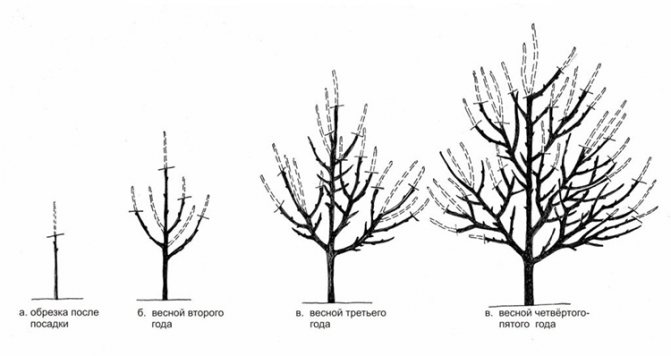

The third year of the seedling. The stem is completely freed from side shoots at the base. Last year's gain is cut by half. On skeletal branches, branches of the second order are formed. Of these, 8-9 external branches are formed.
Further, skeletal branches are not pruned. Shoots growing inside the crown, dry, damaged are removed. Annual shoots are not pruned if they are less than 70 cm. If more, they are shortened by a third.
Crown formation
Crown formation is carried out at any time, but early spring is considered the best period.
Within 4-5 years, a sparse-tiered crown is formed:
In the first year, the top of the guide is cut off. The trunk should be free of side branches.
Next year, 5-6 branches will grow on the trunk. You need to leave only three branches, the central conductor. They will be the first tier of the crown. The distance from the root collar to the branches is 60 cm. At this step, the trunk should be free of shoots. The skeletal branches are shortened by a bud that faces outward. It is advisable that a step of 15 cm in height is maintained between each branch and directed in different directions from the conductor.
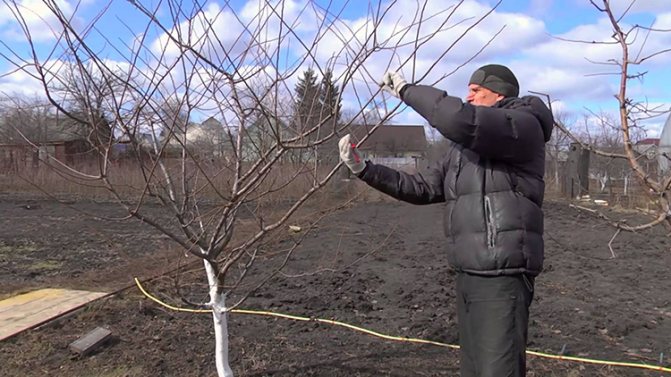

In the third year, growths will appear on the skeletal branches. We leave one growth shoot on the skeletal branch. Choose those that are directed to the outside. The remaining growths are shortened by the kidney. The guide is shortened to a height of one meter.
In the fourth year, it is necessary to continue the formation of skeletal branches - leave one increment, remove the rest. The growths are always pruned to the outside of the kidney.
By the same principle, the second, third tier is formed. Between the tiers, a step of 60 cm is maintained. Competitors cut the branches into a “ring”. That is, without hemp, and the places of the cuts are treated with garden pitch.
Strengthening fruit branches with props
High yields of plums can break branches. To prevent this from happening, props are being prepared. They should be placed in the center of gravity of the branches. Isolate the place of contact with a soft material: rags, grass, rubber. Previously, grooves for skeletal branches are made in the upper part of the support.This will prevent damage to the bark, and there will be no gum leakage (resin).
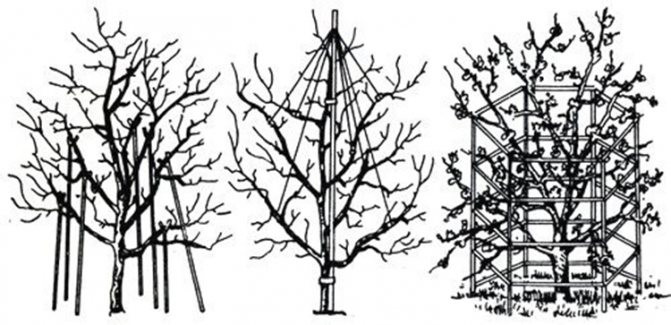

Ksenia
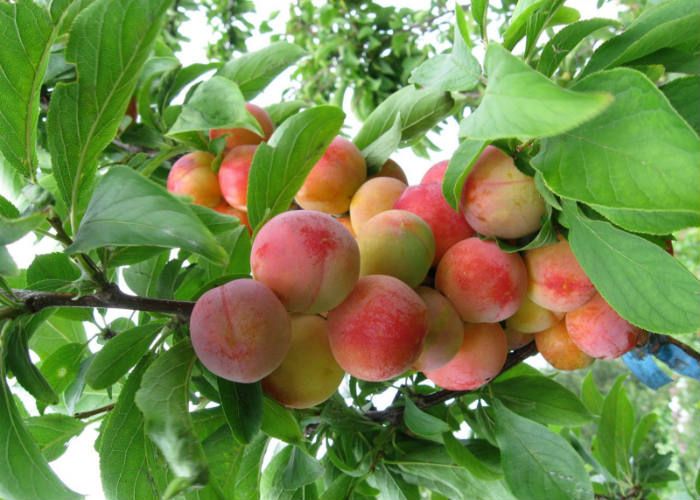

An early ripe large-fruited variety for universal use. The plant does not grow tall. The fruits are shaped like an oval, the weight is 35-40 grams, the skin color is yellow, but there is a red blush, the pulp is sweet in taste, juicy, its color is yellow-green. The variety belongs to the group of self-fertile plum species, it tolerates wintering quite well, the yield is irregular.
Plum propagation
Own-rooted plums are propagated by root cuttings, shoots, grafted with green cuttings, grafts.
A beginner gardener should start with simple propagation methods - undergrowth.
Propagated by root suckers
Shoots appear near the trunk. Usually they are removed, but they can be used for reproduction:
- In early spring, away from the trunk (1 m), an offspring, 50 cm in height, with a well-developed root system, is separated. From the stem overgrowth, the root trimming step is 20 cm. The cut site is processed with ash.
- The seat is chosen in the shade.
- Pinch the top after planting.
- The signal for the rooting of the shoot will be the appearance of leaves.
- After 30 days, the seedling is fed with organic matter and mineral fertilizers. Top dressing should be carried out regularly once every two weeks, so that the seedling grows stronger.
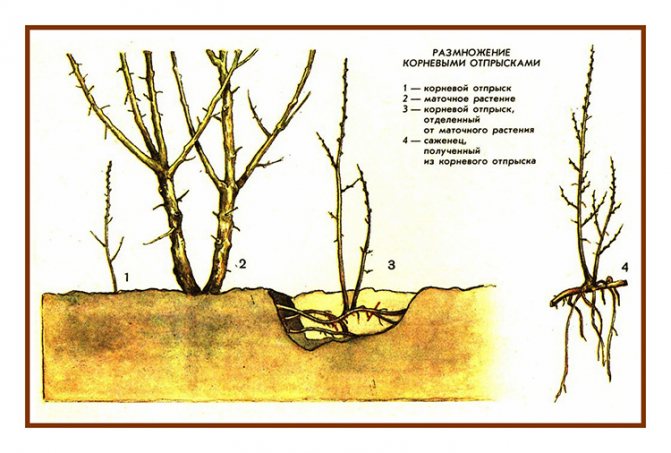

Graft
Reproduction by vaccination retains the maternal characteristics:
- The stock (base) is grown from shoots or seeds. The ideal age is 1 year.
- A bud of a varietal tree is used as a scion. The method of grafting by the kidney is called budding.
- The stock is watered abundantly so that the bark separates well, sap flow increases, and on the day of inoculation, wipe the trunk with a damp cloth to remove dust.
- A strip with a bud (3 x 0.5 cm) is inserted into the stem of the rootstock. To do this, 4 cm recede from the ground and an incision is made in the bark. Gently fold back the bark, insert the shield with the kidney. Wrap the place of budding with cellophane. The kidney remains open.
- The bandage is removed after 20 days.
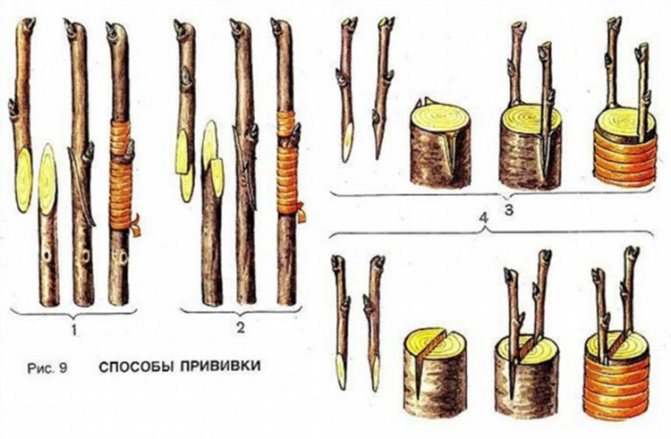

Root cuttings
- 1-1.5 meters recede from the trunk and dig in the root system.
- Roots with a thickness of 0.5-1.5 cm are selected. Cuttings are cut into (15 cm).
- The beds are being prepared, where the roots are planted at an angle, in 10 cm increments.
- The plantings are covered with agrofibre. The material will protect from sunlight and create a favorable microclimate for cuttings. New shoots will appear in a month.
- The strongest specimens are selected and grown.
- Ready seedlings are transplanted to a permanent place after 2 years.
- Further care is carried out as for young seedlings - feeding with organic matter, mineral fertilizers 2 times a week.
- Autumn blanks are sent to boxes with sand and placed in the basement. In the spring they are planted in open ground. Storage temperature 0-2 deg.
How to plant a stone plum
The plum is propagated from the stone. Varieties suitable for this method: Chinese, Ussuriyskaya, Canadian Far Eastern.
Algorithm of actions:
- A ripe fruit is selected. Cultivars grown in similar climates are ideal for breeding.
- The bone is freed from the pulp and washed under running water. It is laid out on the windowsill to dry.
- As soon as the nut dries, separate the seed from the shell so that it remains intact.
- A bowl of water will help to check the viability. A sunken seed is suitable for germination.
- The planting material is stratified in a refrigerator at a temperature of 4 degrees C.
- The seed is stored in moist sawdust.
- As soon as the seed is nailed, the planting material is planted in a pot.
- Care is carried out as a houseplant.
- In the fall, the seedling is planted in open ground.
- Planting should be carried out 1.5 months before stable frosts. After wintering, the seedling is transplanted to a permanent place.
Pests and diseases
Plums, like any other plants, are affected by diseases and pests under poor weather conditions and insufficient care.
The table below shows the main diseases of the crops under consideration and methods for their elimination:
| Name of the disease | Remedies |
| Gum therapy | It appears more often on trees whose bark has been damaged and the wound surface is not properly treated. It is eliminated by stripping the gum to a healthy tissue, followed by disinfection with a 3% solution of copper sulfate and sealing with garden varnish. |
| Dwarfism | Caused by a virus. It is an incurable disease, therefore, when the first symptoms are found, the plant should be uprooted and burned. |
| Plum pockets | Fungal disease affecting the fetus. When a white bloom appears on the fruits and their deformation, the entire branch must be removed and treated with Bordeaux liquid. |
| Clasterosporium disease | A fungal disease that can affect the entire plant. When the first symptoms appear in the form of spots on the leaves, you need to remove the affected parts, and treat with a solution of wood ash with the addition of "Fundazol". For 10 liters of water add 1 kg of ash + 10 g of fungicide. Spraying is carried out not only over the entire ground part, but also in the near-stem circle. |
| Moniliosis | Fungal disease affecting foliage, fruits. It is eliminated by removing the affected parts of the plant, followed by double treatments with 1% copper sulfate solution with an interval of 14 days. |
| Rust | Fungal disease affecting the leafy part. It is eliminated by removing the affected parts, followed by treatment with a solution of wood ash with "Fundazol". |
| Smallpox | The disease is caused by a virus. It is not treated; when characteristic symptoms appear, the tree is uprooted and burned. |
Of the pests for plums, the most dangerous are:
- leaf rollers - eliminated by processing plants with "Karbofos" according to the instructions;
- aphids - a solution of wood ash with "Fufanon" (10 g per 10 liters of water) is used to combat it;
- rose leafhopper - is eliminated by dusting the plant and the entire area around the trunk with tobacco dust;
- false shield - to get rid of this pest, use Fitoverm (1.5 ml per 1 liter of water) twice with an interval of 10 days;
- sawfly - "Fufanon" will help to cope with it (to breed, as to eliminate aphids).
Important! With the frequent appearance of pests and diseases on the site, you should not use the same drug every year to combat them, since bacteria and microorganisms quickly adapt to poisons.
Blossom, but do not bear fruit
Novice gardeners are faced with the fact that the plum blooms beautifully, but does not bear fruit.
Self-fertile plums cannot bear fruit without a pollinator. For such purposes, pollinating plums are planted. Each variety has its own pollinator, but if for some reason you do not know the pollinator of your variety, you should follow some rules when choosing:
- tree with annual flowering;
- life expectancy with the main variety is the same;
- good-quality pollen in abundance.
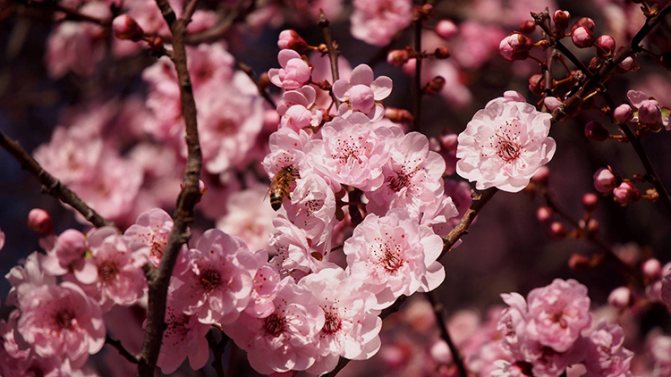

Among self-fertile varieties, varieties are distinguished:
- Early blue.
- Memory of Timiryazev.
- Common Hungarian.
- Spark.
- Early ripening red.
- Home Hungarian.
- Hungarian Moscow.
Trees are planted within 60 meters.
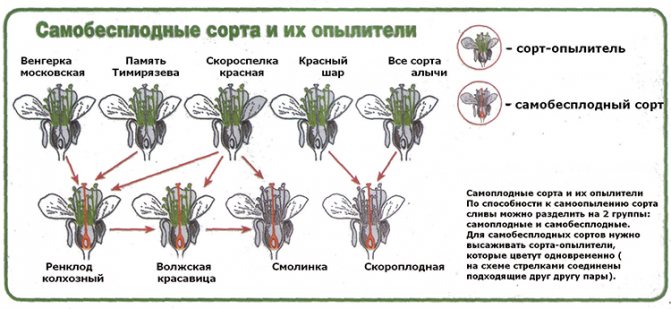

Other reasons:
- The ovaries are destroyed by pests.
- Insufficient feeding in the fall. Fertilizers during this period are responsible for future fruiting.
- The trees did not have enough moisture.
- The region does not correspond to the given variety.
- Soil with high acidity. Dislikes wood and swampy places.
- Incorrect planting techniques. When planting, the root collar is buried and the tree is sick. The tree spends all its strength on restoration and fruiting does not occur.
- Plum age.
Harvesting and storage
Plums begin to be harvested as they ripen. Usually, the fruit yield is extended for a month. If the fruit will be used for preservation whole or compotes, then the collection is carried out a little earlier than they reach physical maturity.
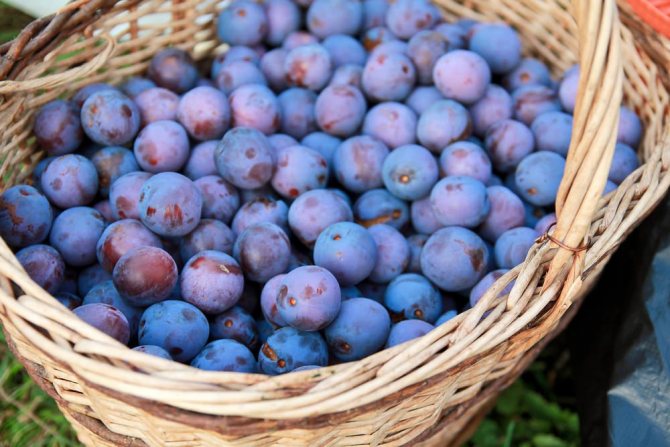

The fruits are removed from the branches along with the stalks and immediately placed in plastic or wooden boxes lined with paper. No more than 3-4 layers of products are placed in a container. At a temperature of + 5 ° C, the absence of light and good ventilation of the room, the fruits of the varieties Vengerka and Pamyat Timiryazeva can be stored for up to 4 weeks, the rest are mostly 2. When stored in a refrigerator, the period is 2 weeks. If you need to extend the shelf life, it is better to process the product or freeze it.
Plums are a unique crop that was formed independently by cross-pollination of blackthorn and cherry-plum. Having absorbed all the best qualities of parent plants, the culture is perfect for use as a fruit, berry, honey plant and a successful accent in the landscape.
The benefits of the fetus and seeds for the human body
Due to the huge amount of vitamins and minerals, the benefits of plums for the human body are very significant. The following properties are considered to be the most valuable:
- Strengthening the immune system. The presence of a complex of useful components increases the body's protective ability, which helps to fight various infections and viruses.
- Normalization of metabolism. The combination of fiber with organic acids helps to improve the metabolic process.
- An increase in hemoglobin levels due to the presence of iron in fruits.
- Improving the performance of the gastrointestinal tract. Plum is a fruit with a laxative effect, it helps to cleanse the body of toxins and toxins.
- Maintaining the work of the heart. Large amounts of potassium are clearly required for heart health. This helps to lower blood pressure and normalize blood circulation in general. The pulp helps to strengthen the blood vessels. It has a positive effect on the consistency of blood, which reduces the risk of blood clots.
- Strengthening the nervous system.
- Cancer prevention.
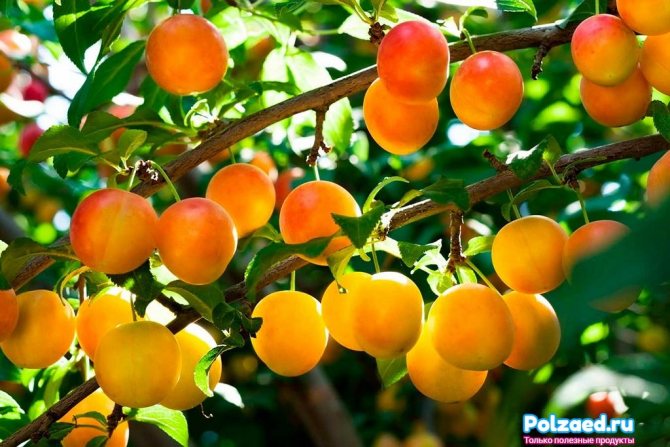

Due to these useful features, plums are widely used in various fields.
In medicine:
- a decoction of inflorescences is used as a laxative, it is prescribed for both children and adults, since it has the property of removing toxins from the body;
- a decoction of the bark and branches is used as an anti-inflammatory and expectorant agent, used to cleanse the gastrointestinal tract in inflammatory processes, at high temperatures;
- juice is useful for colds and cardiovascular diseases;
- plum broth promotes wound healing due to its pronounced bactericidal effect;
- dry has antipyretic effect;
- improves vision and memory;
- increases appetite;
- used for weight loss, it is the main component of the "plum diet".
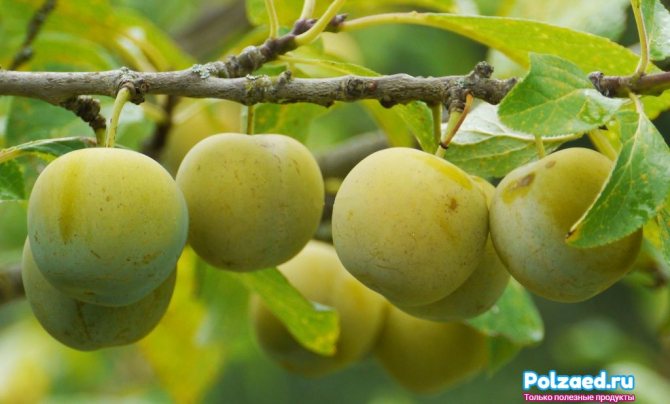

In addition to fruits, plum seeds are widely used in medicine.
Tinctures prepared on their basis have healing properties. They are often used:
- at various stages of bronchitis;
- with prolonged cough;
- to prevent cancer.
In China, festering wounds were washed with a decoction of plum and cherry pits, infectious diseases and high fever were cured.
Imperial
This is one of the first columnar varieties of plum, which today is popular with gardeners in the Moscow region, thanks to its juicy and large fruits. The fruits are rounded in shape and weigh up to 55 grams. The skin is firm, reddish brown or purple. The pulp has a beautiful golden hue and a pleasant sweet taste with a slight sourness.
The variety is universal - the fruits can be used for making stewed fruit, jams, preserves, and also consumed fresh. The advantage of the variety is self-fertility and self-pollination.
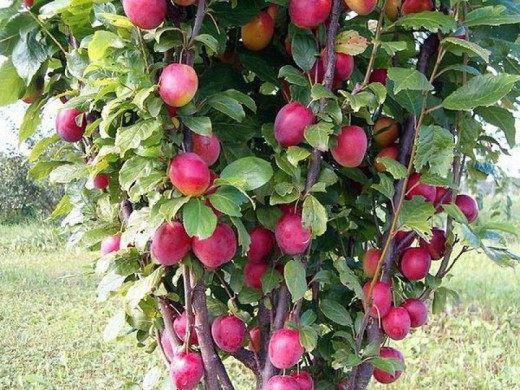

Nika
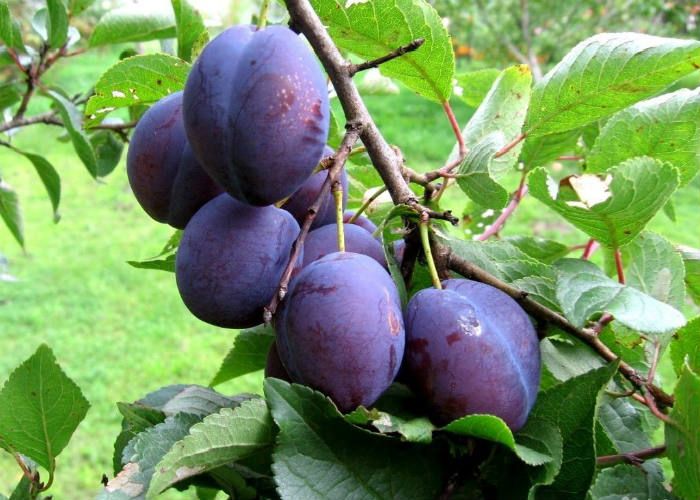

Representative of early ripening plum varieties. The height of the tree is usually average, but there are also strong-growing specimens, the plant is spreading, the crown is not too dense.The fruits have an oval slightly elongated shape, the average weight is 40-50 grams, reaching biological ripeness, the fruit skin becomes a dark purple hue, plaque is present. The structure of the pulp is dense, juicy, sweet on the palate. The variety is immune to common plum ailments.
Chemical composition
The fruit is rich in various vitamins, as well as micro- and macroelements that are valuable for the human body. The calorie content of fresh plums is only 45 calories per 100 g:
- proteins - 0.8 g;
- fats - 0.3 g;
- carbohydrates - 9.6 g;
- water - 86.3 g;
- dietary fiber - 1.5 g
However, it must be taken into account that prunes are more nutritious than fresh fruit. Its nutritional value is about 255 kcal.
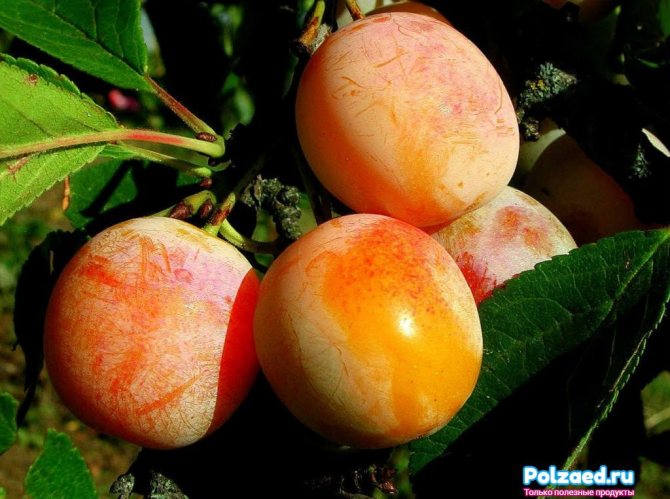

The fruits contain 9-15% sugars, namely fructose, sucrose and glucose. Also, the fruits are rich in minerals (shown in table. 1) and vitamins of groups A, B1, B2, C, H and PP.
| Trace elements | Macronutrients |
| Fe | Ca |
| Manganese | Potassium |
| Fluorine | Chlorine |
| Nickel | Magnesium |
| Zn | Phosphorus |
| Iodine | Sulfur |
| Silicon | Sodium |
| Copper | |
| Chromium |
Due to its rich composition, plum is a useful fruit for vitamin deficiency.
In cooking
Plum is a fairly popular representative of fruit-bearing trees. It can be consumed fresh, various desserts and sweets, compotes and preserves, drinks and various sauces are prepared from it. Lovers of alcoholic drinks make plum liqueurs and liqueurs. Use it as a barbecue marinade. Prunes (dried fruit) are popular.
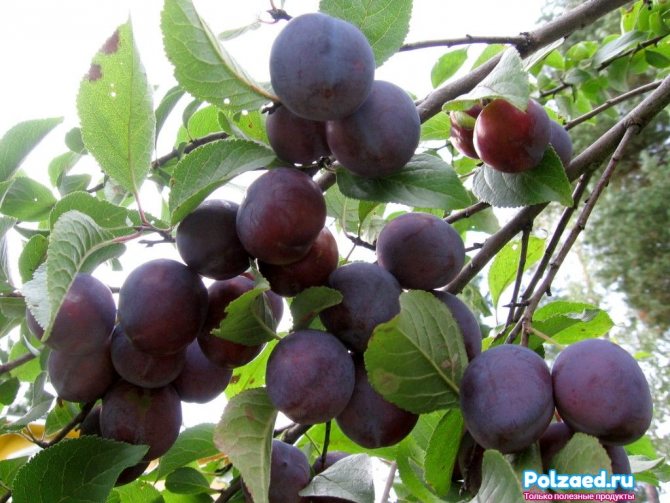

Feature of self-fertile varieties
Today we will present you self-fertile varieties of plums for the Moscow region, but first, a few words about what the term “self-fertility” means. This is the ability of a plant to self-pollinate without the participation of bees and the neighborhood of trees of a related species.
Such trees, when cross-pollinated, give a significantly higher yield, since in this case both their own pollen and the pollen of neighboring trees are the pollinator. Under the influence of climatic conditions, partial self-fertility occurs, which is characterized by lower productivity.
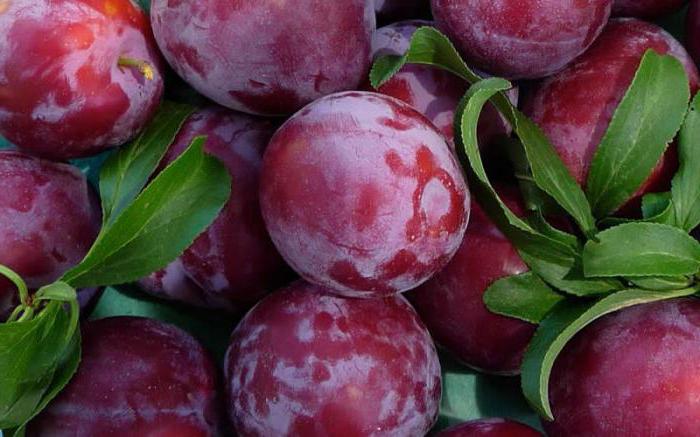

Advantages and disadvantages of the variety
The main decorative difference of the Cisten plum is its unusual red leaves, which give the culture a splendor.
- It is for them that the plant is valued most of all, but it also has other advantages:
- early flowering;
- preservation of high decorative effect after leaves fall;
- compact shape and ease of crown formation;
- versatility of the use of fruits;
- great taste of cream;
- the possibility of growing in the form of a slender tree, after the stock on a stem of other varieties.
- As for the disadvantages of the variety, this group includes:
- medium or even low resistance to diseases and pests;
- the need for a winter bush shelter.
Blue gift
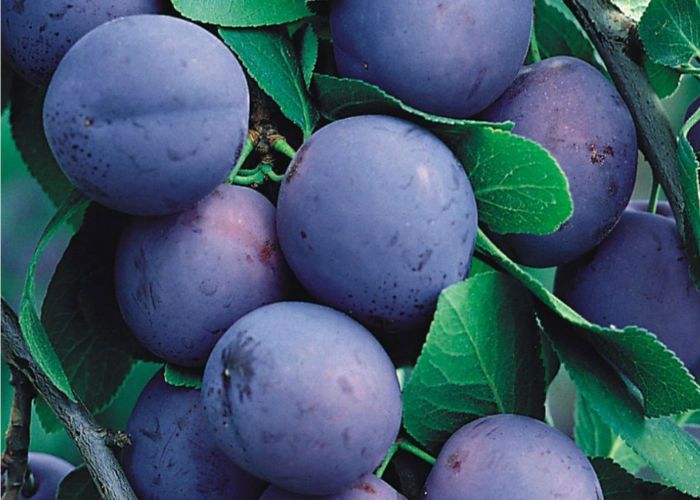

The variety has early maturity dates. The tree does not grow very tall, the crown is not thickened. The oval shape of the fruits and their small size (10-15 grams) distinguish this variety from others, the skin tone is dark purple, and a waxy coating is present. The pulp is green with a yellow tinge, the structure is dense and juicy. The cultivar is self-fertile and does not require pollinator plants.
Yakhontova
The best varieties of yellow plum for the Moscow region (self-fertile) in our article are represented by this variety. The tree grows up to five meters, it is not afraid of spring return frosts, which are often the reason for the death of flower buds in most fruit trees. Large and juicy sunny fruits (35 g), have a bright and rich sweet and sour taste. The variety is high-yielding - up to fifty kilograms of plums can be removed from one tree.
Harvested from late August to mid-September. The tree easily tolerates dry days, is resistant to fungal and viral diseases. The only drawback: the fruits need urgent processing - they are not stored at all.
How to grow a plum from a cutting
You can grow a plum not only from a stone, but also by grafting. To do this, in mid-June, you need to cut young green cuttings. The length of one branch is about 20-30 cm. It is better to cut it in the morning in cool weather, so that the tree does not experience unnecessary stress. The harvested branches are immediately placed in water for germination (Figure 8).
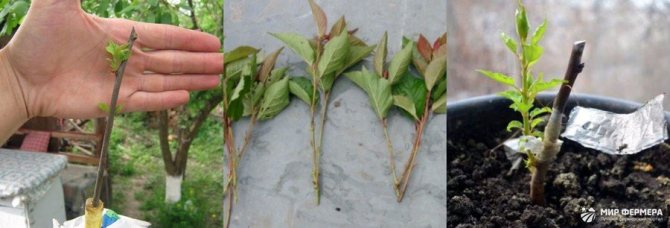

Figure 8. Preparing cuttings for planting
It will be better if a few leaves remain on the cutting. Such shoots will take root much faster and turn into a full-fledged tree.
Advice
Interested in how to properly plant a plum in the spring from a cutting, it should be borne in mind that special growth stimulants will help speed up the formation of roots. Such preparations are used instead of ordinary water for germinating cuttings.
Schedule of feeding plum trees
| Duration of feeding | Recommended fertilizer |
| First decade of May | Dissolve two tablespoons of urea in a bucket of water. Wood consumption is 1 bucket. |
| First decade of June | Dissolve 3 tbsp in a bucket of water. l. nitrophosphate. Wood consumption is 1 bucket. |
| Mid august | Dissolve two tablespoons of superphosphate in a bucket of water. Wood consumption is 1 bucket. |
To increase the yield, foliar dressing can be carried out with a 0.5% urea solution. The number of such dressings should be from two to three per season.
Watering rules
To water one young or medium-sized plum tree, use at least three buckets of water per week. To water tall and abundantly fruiting plants, you need to increase the amount of water by one and a half times.
The most optimal watering times are in the spring-summer period, when there is an active development of buds, flowering and formation of ovaries. Mulching the soil will reduce moisture evaporation.
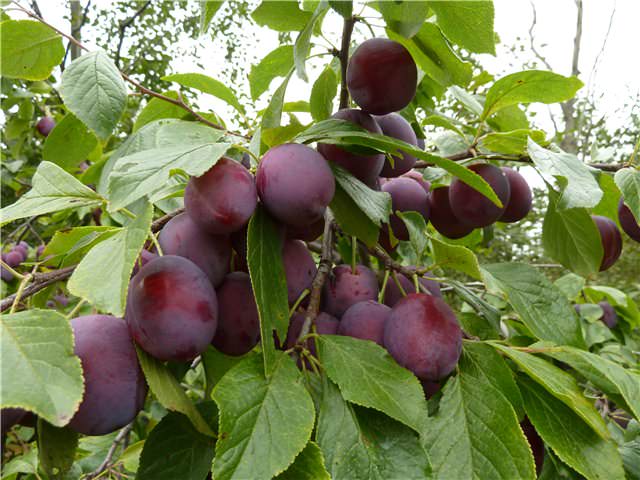

Crown formation
In order for the plum tree to have an attractive and easy-to-maintain crown shape, the most important stage of cultivation is to carry out formative pruning. The optimal shape of the crown is a sparse-tiered type.
The stem of the tree should not be higher than 40 cm. At the bottom, no more than 3 branches should be left. On the second tier, you need to leave 2-3 branches. All subsequent tiers must have one branch.
Winter preparation and frost resistance
Preparation of seedlings for winter is carried out in the autumn. The process includes the following activities:
- autumn pruning - sanitary and formative;
- top dressing - with the exception of annual seedlings;
- water charging irrigation;
- whitewashing of trunks;
- insulation and protection from rodents.
Warming and wintering depends on the age of the tree and on the severity of winters in the region. So, young trees are recommended to be insulated, and one-year-old saplings should be buried in the snow for the winter.
The procedure for insulating wood:
- dig up the soil in the trunk circle;
- young trees are tied to a strong support, and their branches are tied in a bunch - to withstand the winds;
- the trunks of young trees are covered with hay, wrapped in paper and tied with a rope;
- to protect the trunk of an adult tree from rodents, it is wrapped with burlap, roofing material, fiberglass, metal mesh, and spruce branches.
- For large trees with branches extending from the trunk at an acute angle, supports are placed to prevent the branches from breaking off under the weight of the snow.
Preparation for wintering depends on the region:
- In Siberia and the Urals, trees of any age are insulated.
- In the middle lane, young trees are insulated, and pre-winter care is reduced to pruning, whitewashing, digging and other agrotechnical measures.
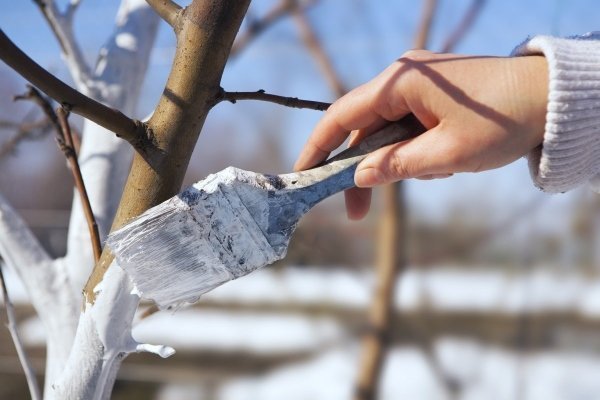

Korneevskaya
Self-fertile varieties of plums for the Moscow region often cause serious disputes between gardeners. For example, some believe that Korneevskaya has too long a period of entry into fruiting (up to 6 years), their opponents are sure that such a long wait for the harvest is more than justified by the high yield, which reaches 50 kilograms per tree. In addition, it has tasty, aromatic and juicy fruits. The obvious disadvantages of the variety include instability to some diseases of stone fruit.
"Golden" fruit
The golden plum or ikako is a squat tree that is 1 meter high. Its natural habitat is the tropics of America and Africa.
Features of the:
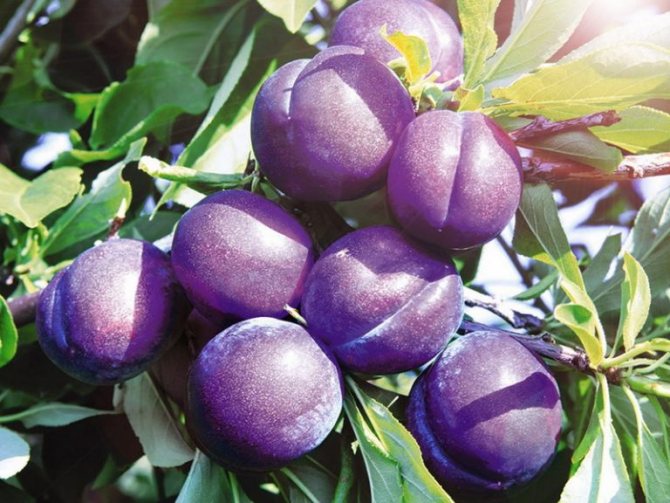

Resistant to salt soil.- Thermophilicity.
- Collection of fruits in bunches.
- Sweet and sour taste.
- Energy value per 100 g - 49 calories.
- Large bone, tightly attached to the flesh.
- Reduced resistance to disease and infection.
The pulp of the fruit is widely used for the production of natural black dye, and the grains are used for the factory production of butter.
The fruit of this variety is highly valued in medicine. Doctors advise it to be regularly used by patients with diseases of the gastrointestinal tract, with hypertension, to normalize the water balance in the body and as a diuretic.
In cooking, jams, preserves, ice cream and jelly are made from these fruits, canned and frozen.
Mara
Today, in the vicinity of the capital, in many garden plots, plum grows well and bears fruit for the Moscow region. It is rather difficult to name the best self-fertile variety, because, firstly, there are a lot of them now, and secondly, in most cases, the choice depends on your taste preferences: someone loves only sweet fruits, someone must have sourness in their taste, some like dense pulp, others prefer more tender and juicy, etc.
Plum Mara tolerates rather harsh winters, has strong immunity to most plum diseases. The tree grows no more than three meters, has a beautiful crown in the shape of a ball, which needs formative pruning. The variety is early - the fruits ripen at the beginning of July and, what is remarkable, without falling off, they can hang on the branches until the beginning of August, without losing their taste.
The skin is colored deep yellow, the flesh is slightly lighter. The taste will delight lovers of sweet fruits. They are perfect for making jams and preserves.
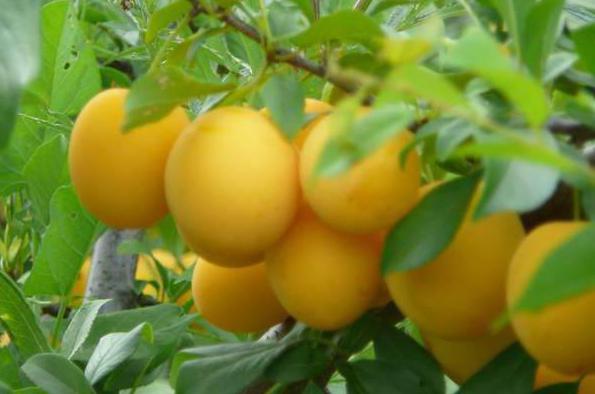

Oryol dream
Many summer residents believe that in recent years the best varieties of plums have been bred for the Moscow region. Self-fertile, low-growing plants give excellent yields and are very easy to care for. Indeed, the Oryol Dream is a variety that has recently appeared in gardens, but has already won many fans.
It has large, rounded fruits (up to 43 grams) of red color, with numerous subcutaneous specks. This is a table variety with an average yield, but at the same time it is highly resistant to many diseases and winter hardiness. It is impossible not to say about some of its shortcomings - the fibrous pulp and the difficult separation of the bone.
So, we have presented you the best self-fertile varieties of plums for the Moscow region. Which one to choose is up to you. We hope that you will be able to grow and reap a good harvest of these healthy and tasty fruits.
Use in cosmetology
Everyone knows that plums can be consumed not only internally, but also used as a cosmetic product. An important point is the absence of allergic reactions to the fruit.
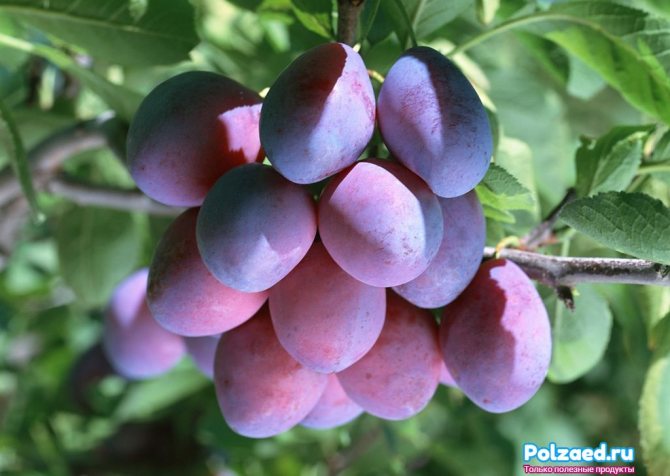

On the basis of decoctions, various masks for the skin and hair are common:
- The gruel from the pulp nourishes and moisturizes the skin well, it becomes soft and silky.
- Has a beneficial effect on the skin around the eyes.
- The broth helps in the fight against dryness and brittle hair.
- Plum extract is used to care for cuticles and nails.
It is often used as a flavoring agent in various products.
Plum seed oil, used alongside almond oil, has the same properties.
Prunes
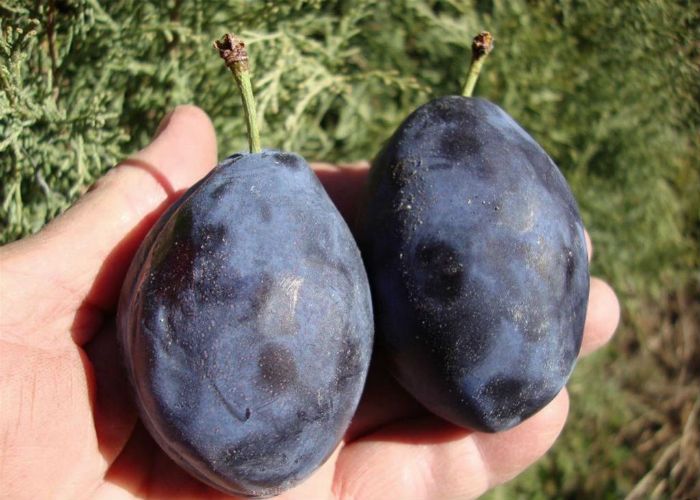

The ripening dates of the fruits of this variety of home plum are medium late. The fruit tree grows quite tall, the crown is not too dense. The shape of the fruit is often rounded, less often rounded-elongated, the mass varies from 40 to 60 grams, the shade of the dense skin is blue-violet, the flesh is yellow, the taste is sweet. The variety is self-fertile, high-yielding and winter-hardy.

